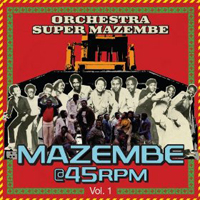
ORCHESTRA SUPER MAZEMBE
MAZEMBE @ 45RPM VOL 1 (Stern's)
I've told this story before, but at the time I was in East Africa 30 years ago, being blown away by the music, I had no idea it would become a lifelong obsession with me. When I returned home Talking Heads sounded jerkily arrhythmic, Einsturzenden Neubauten, Wire and Public Image Ltd were no longer even tolerable (I sold or gave away their records), and all I wanted was to find and listen to more Congolese, Tanzanian, Zambian and Kenyan music. One genre in particular held my attention and that was the bands who played in East Africa but came from the Congo basin and sang in Lingala. I had seen Orchestra Virunga of Samba Mapangala and Moreno in concert in Nairobi and my interest quickly fanned out from them like a brushfire. That these bands are all consistently great, even the really obscure ones like Orchestre Kot Kot or Grand Piza, is due to the fact that they had a fluid membership drawn from the pool of expatriate musicians in Nairobi. I am not saying they sound alike but there are familiar voices (such as Fataki Lokasa), familiar rhythms (e.g. the Cavacha) and even catch-phrases ("Sikiya sauce!") that echo between these bands. Among the best was Super Mazembe, the "Earth movers." Their new Stern's album is another dream come true: It sounds as fresh now as it did 30 years ago, which says as much for the music as for Doug Paterson's loving restoration of the singles from A-side B-side tracks which had lain forgotten for three decades. If you poke about cyberspace and YouTube you can find enthusiasts for this music, usually content to listen to fried third-generation versions taken from the famous much-bootlegged originals found in the shacks on River Road or the "scruffy dukas" along the Thika Road (as my sister-in-law called them) and now worn down and scratched. Super Mazembe were one of the most successful, they even had LPs released in Europe (on Virgin and Disc'Afrique). Their genesis was in Orchestre Super Vox, formed in Likasi, Zaire. The leader of that group, Mutonkole Longwa Didos, moved to Nairobi with a core band in 1974. Katele Aley was lead singer and composer (he wrote most of the songs on here); Kassongo Songoley played rhythm guitar while Kassongo wa Kanema was another singer. In Nairobi their ranks were strengthened by Loboko Pasi (guitar), Fataki Lokassa (singer) and high-register vocalist Lovy Longomba, who like Baba Gaston, was also from Likasi and even used the name Bana Likasi (Likasi Kids) on some recordings. The hits flowed from their creative fusion and they released a staggering 42 singles on their own label Editions Mazembe and several on the Zambian Luapula label of Nashil Pichen Kazembe, who also wrote and sang with the band during his sojourn in Nairobi. Here we have nine choice examples of their style, each eight and a half minutes or so of brilliance. The vocalists state the subject (often homilies about interpersonal relationships: "I cant find a job, everything has an end and eventually my suffering will end, but for now I need help," or "My husband drinks all his wages. How can I raise the children? Maybe I should marry his brother?") in sweet harmony, then from about two to three minutes in, the drummer knocks his tomtom twice to signal "Here we go!" The guitarists step up and start to weave complex webs around the melody. But they are reined in at the four minute mark and the vocalists return and it sounds quite literally like the band is falling apart: the lead guitar sputters and conks out, the vocalists sing the harmony only, one of them yelps and calls out names, soon all we have is the manic drumming and the rhythm guitar, suggesting everyone else went to the bar or the bathroom. But we are in capable hands: the others are simply concocting a surprise (and what is happening in the studio is the engineer is giving them a wind-up signal as he is planning where to slice the song into two parts). As you know part two is a free-for-all race to the finish, and it's not uncommon to hear the rhythm guitar or even the bassist get a shout-out for their sudden inspired innovation. It's as close to a live jam as you can get without the attendant problems of live recordings which are often great in memory until you hear them back and the vocals are off-key or one player is too loud or the sound is muffled. The sound here is generally clean and bright. The selection is fabulous and bodes well for future volumes (I was never that impressed with their so-called "Greatest Hits" album as it had a couple of cover tunes including a Buddy Holly song which was a novelty item and not that memorable). This is what they are all about: Aley Katele's sharp songs (all the lyrics are explained), Bukalos Bukassa's lead guitar, solid drumming from Dodo Doris or Ngoi Kitenge wa Kitombole, Atia Jo on bass, and a revolving roster of back-up singers, animators (in-style guys who dance and shout encouragement) and third and even fourth guitar players dicing in some extra riffs. Among influences you can hear OK Jazz on "Amina." All the tracks are exceptional & I do hope Stern's have turned Paterson loose on the next batch of tapes.

BLUE FLAMINGO
A SEARCH FOR CMS (Excel 90306)
You may know the Blue Flamingo label through Ziya Eretekin's elegant blog about classic 78s. Last year he went to Nairobi searching for information about a label, Capitol Music Store (CMS) that flourished in the postwar era alongside Melodica and AGS. The fruits of Ertekin's trip are the 14 sides collected here that showcase the development of acoustic folky music into benga in the era before the Congo sound began to influence music in Kenya and Tanzania. It's a handsome package, with a 26-page booklet to enjoy while you bask in the bygone sounds. For me it's wonderful that so much great African music is being unearthed and treated properly with the respect it deserves and not just ripped and uploaded from scratchy or dubious source material. You can read the liner notes on Ertekin's website, and follow his crazy serendipitous one-day trip to find out more about CMS. A taxi ride from Melodica brings him to a musicians' convention where he meets Joseph Kamaru, formerly a very successful singer, who had bought CMS when the Indians were forced out of business, and renamed it City Sounds. Then he runs into George Mukabi's son who gives him an impromptu concert, so all in all Ertekin has a phenomenally productive day in Nairobi. His compilation is a choice set of 14 sides that chronicle the music in a familiar way (So familiar that Ben Blastus singing "Mpenzi nipe pete" put me in mind of "Brown-eyed girl" by Van Morrison!). Things turn electric with Victoria Revolution 73, a full-blown Benga band. We go back to guitar and Fanta-bottle and then ease back into electric pop with the mellow sounds of Melodica Success: the singing is still benga style, but the trumpet and guitar styling are reaching into the pan-African musical pool. They even call out "Mutuash!" at the seben. The most famous artist on here, after George Mukabi (who gets two selections) is John Ondolo who also gets two selections, "Shokoloko Bango," and "Kilimanjaro." There is also a nice balance between acoustic and electric tracks.
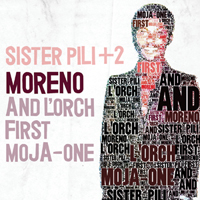
MORENO and L'ORCH FIRST MOJA-ONE
SISTER PILI + 2 (Stern's STCD3062)
You know there's one thing I love dearly and that is classic Congolese music. There's also the variety of expat Congolese in Kenya that I have devoted many column inches to, explaining that the musical scene in Congo was so rich in the late 70s that bands went East looking for gigs and many settled in Uganda, Kenya and Tanzania, reinvigorating the local scenes. These musicians flowed in and out of different configurations but there were several key performers, including arguably the finest singer of the era, Moreno, subject of this reissue. It consists of a fine album with never-before-known bonus tracks. Moreno was handsome and charismatic, as well as having a rich bass voice that is on the verge of cracking, lending it loads of emotion; his charm extended to eliciting the best performances from his musicians.
The combination of dueling lead guitars, sax punctuating the harmony, and pounding bass is irresistible. It sounds as though they are jamming live in the studio and the tunes have all the excitement of first takes, urged on by a very excited Moreno. After all this is the "First" band, not only that, First Moja-One. (As any African traveller learns, "Moja" is Swahili for "One" so Moreno is overstating it just a bit!)
The album, Sister Pili, returns in glorious sonic fidelity thanks to Doug Paterson. When I record old scratched LPs I tend to leave them alone; I know from years of playing with Dolby, hi-bias and/or cheap cassettes that anything you do to a signal is only going to cause it to degenerate. Doug got hold of the master tapes and they've been sonically cleansed to an unbelievable degree of clarity. In addition to this rare Sister Pili album there are bonus tracks that I don't think anyone has heard since they came out in Nairobi back in the day. Particularly notable is the song "Teresia," which should be a chart-topper!
What's truly great about this reissue is how clearly you can hear everyone, including Moreno, presumably, suddenly grabbing a beer bottle and tapping it to add to the beat. The guitars are in separate channels too so the stereo effect is fantastic. A band this tight has to be heard to be believed. Since these musicians were in several bands (basically any of the Congolese expats who had a gig would call on them), they can stop and start on a dime, know how to improvise and then, when someone is cooking the others give him some room. You notice this even with the bass player (Tommy Lomboto) who is bustling throughout and even becomes the lead instrument a couple of times. Lava Machine is on the drumkit, though sometimes Kaster or Hassani add other percussion or take over from him. The drummer steams along on snare, high-hat, kick bass & tom-tom drums. Simple is best.
Frankai Kayuba adds sax; Bibiley, Mokili, and Siama get shout-outs as the lead, rhythm and mi-solo guitars. Presumably the backing vocals are Coco Zigo Mike, Monimambo Jim, and others from Shika Shika and Bana Ngenge.
The bonus tracks are by another incarnation of the band, called Bana Nzadi, with Tabu Ngongo (later of Les Mangelepa & then Vundumuna) on sax and Sammy Kasule (of Special Liwanza and Les Kinois) on bass. Madjo Maduley sings harmony on these, and the accompaniment is by "Professor" Siama Matuzungidi once again. You wouldn't expect the second guitarist to get a shout-out until you hear the amazing interplay between them. Doug Paterson guessed it might be Moreno from the title, "Rehama-Piri," and wondered if it could be another song dedicated to the lovely Tanzanian model who was Moreno's muse. He was right and the 1977 bonus singles by Orchestre Bana Nzadi on the obscure Pope Label are a true gift from the past.
The Congo-in-Kenya genre of music is incredibly rich as I discovered when I started a page about it, and soon found other fans rushing to send me info in their own excitement. There are many plums in this particularly pudding & I hope Stern's will continue to unearth, restore and re-present this remarkable music to our ears.
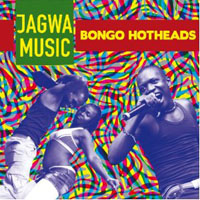
JAGWA MUSIC
BONGO HOTHEADS (Crammed Disc CRAW80)
Straight off the streets of Dar Es Salaam comes this fierce band of Bongo Hotheads. I haven't heard anything this intense and raw since Konono Numero Un. Jagwa Music is another fount of unstoppable energy. This ensemble have home-made drums and, as lead instruments, two old battered Casio keyboards wired to homemade amps. Singers and dancers complete the line-up. While the music is trancelike and repetitious, the fuzzy Casio lends grit and weirdness, and the pace suggests Afro-Punk. The mainstream media in Tanzania ignore this shanty-born music, deriding it as the music of thugs, but it has had a strong following for twenty years now as the band has continually renewed itself with young singers and performers. Vocally, the songs recall the old sound of Tanzania (Shikamoo and co), and are about lost love, voodoo and other popular topics. The producer of this hi-level insanity is Werner Graebner who has a distinguished career as one of the leading African musicologists today, author of Sokomoko. Popular culture in East Africa (Amsterdam, 1992). His record production credits include the Zanzibara series, Abana ba Nasery, Culture Music Club, as well as work on Mlimani Park Orchestra's Sungi and also Masimango, the great remastered reissue of Mbaraka Mwinshehe. While these wonderful albums are a treat to us in our small circle of cognoscenti, this Jagwa Music deserves to break out to worldwide acceptance and popularity.
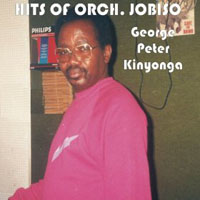
GEORGE PETER KINYONGA
HITS OF ORCH JOBISO (TCK Records)
I am really not happy about the direction the music industry is headed. Amazon and iTunes dominate the field of downloads and I have to ask, Is anyone listening? I mean really listening to music, either with good headphones or on a real sound system? Their bit-rate is miserable and when you reissue an album that was originally on cassette it is going to sound like you are hearing it in a tin can via a piece of string. (Unless you have Doug Paterson doing audio restoration!) Fortunately other sources are available for the Orchestre Jobiso reissue of pure "Muziki wa dansi" (which still has some warbly tape rumble moments in the bass). It's four of their hits (A side plus B side, with a gap in the middle, so if you are energetic you will have to edit the files to eliminate the silence in the middle) from the late 70s. There's a picture of George Peter Kinyonga about 100 pixels square and no other info, other than titles. George and his brother Wilson were the founders of the legendary Simba Wanyika in Tanzania, pioneers of Swahili rumba. They started out as Jamhuri Jazz in their hometown of Tanga, Tanzania, and then moved to Arusha where, inevitably, they evolved into Arusha Jazz. In 1970 they moved to Nairobi, Kenya, and became Simba Wanyika (Lions of the Desert). The Super Wanyika Stars story is relatively well known and Sterns has done a glorious job of reissuing the Issa Juma material recently. Orchestra Jobiso was George Peter's outfit after the fracture of the Wanyika band into several offshoots. The cassette, er download, collects four of his hits.
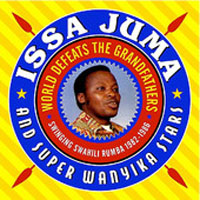
ISSA JUMA & SUPER WANYIKA STARS
WORLD DEFEATS THE GRANDFATHERS vol 2
MORE SWINGING SWAHILI RUMBA 1982-6 (Sterns download* in 320 bitrate from 7digital)
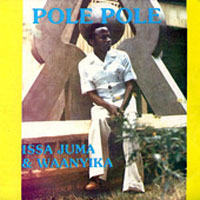
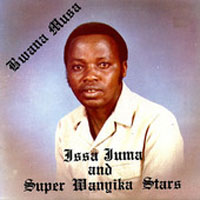
This is a download-only album you nevertheless have to own, and to satisfy your need to have something in your hands to look at while listening, you should pull out the booklet from Volume 1 and reflect that Sterns' East African series is now up to 5 discs and is catching up to the essential Guinea sets put out from 2007 onward (which is up to 5 double-disc sets). Don't worry there's plenty more great East African music & this disc is no less impressive than Volume 1. "Teresia," which was a smash hit single in the mid 1980s is included, as is "Sauda," a killer cut from the Mpita-Nija album (three of the four tracks from that album were on Volume 1, so completists will be thrilled!). The stellar "Sarah," another long-time favorite, which was included on Sigalame 2 is here, along with the title cut which may be the one Issa Juma track you know if you had that Discafrique album that came out in Europe in 1990. That was their breakthrough album to Western ears & I am glad it has been digitized because I played mine so much it skips now. It's a good thing Sterns decided to include it here because it is truly one of the great East African songs and, after 22 years, there may be some people who missed Les Wanyika Stars then. "Selemani" & "Pole Issa" are here with a few other tracks previously unknown, even to the congnoscenti! And if you recall the first volume ended with "Ma Eliza" in an unreleased version with a sax solo; this one ends with a different take of that same tune. In it you can hear Omar Shabani trying out some Franco-style staggered guitar licks. Interestingly Sterns still haven't got to their early work as Les Wanyika, songs like "Sina Makossa," "Pauline" and a few others from the late 70s that maybe will be on Volume 3. Doug Paterson writes: "It just speaks to the largely unrecognized talents of Issa Juma that practically everything he did for AIT still sounds great: great rumba with a Tanzanian sensibility with the benga pulse; and often, perhaps unintentionally, a raw / gritty sound that I find quite appealing." Though the good songs are all now collected on these two volumes, Stern's has also released two of the Wanyika LPs --Bwana Musa and Pole Pole -- with their original track lists, and you can download those Golden Oldies separately if you prefer. (*Ken A, who has more experience than I in these matters, reports that amazon and iTunes generally encode their files at 256 kbps; with emusic you never know what you're going to get -- sometimes half of that -- but other than 7digital, othermusic and dancetracksdigital sell music for the same price as amazon and iTunes.)
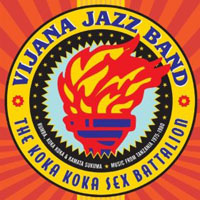
VIJANA JAZZ
THE KOKA KOKA SEX BATTALION (Stern's STCD3053)
From the time Stern's announced this release and started posting teasers on their website and Soundcloud, I have been as excited as a kid waiting for Santa. I have a lot of Vijana Jazz (11 cassettes and several tracks on comps), most of it slightly warbly sounding tapes, and a thrashed 45, as found on my Tanzanian discography page. Interestingly only one of those tracks I list, "Gubu la Mume," from Swahili Hits vol 4, is gathered here. The rest magically appeared from nowhere, or rather from the sleeve of Doug Paterson, compiler and annotator of this excellent series. Not only is this Tanzanian muziki wa dansi series going from strength to strength, it's impressive for two other reasons. First, the sound is restored to audio excellence. Yes, you can go off into the blogosphere or YouTube and find music sort of like this, but chances are if anyone has made an effort to clean it up they have just added a filter to make it more fuzzy sounding. If you don't have access to the source material you are starting at a disadvantage. Tapes may not have surface crackles like 45s, but are blighted by other problems. Secondly, not least among the attendant problems of this music "at a few removes" is the documentation. It's fine to have African music on your iTunes but if you don't know what the song is about, or who wrote it or why, it has less meaning.
Considerable sleuthing went into the discovery of these Vijana Jazz master tapes. First of all 6 of the tracks were released pseudonymously, under the imaginative title of The Koka Koka Sex Battalion. The reason was simple: the band's label in Tanzania thought they had enough material on the market, but the members were burning to record more recent stuff and knew if they drove to Nairobi, where there were good studios, they could cut some new songs and get paid for them, hence the surreptitious aspect of this venture. So after a New Year's Eve concert to bring in 1975, the hung-over members got into a truck with their guitars and amps and headed north to Kenya as Ali Mohamed, their driver, navigated the giant potholes and herds of goats along the red dirt highway. (That's conjecture on my part; maybe they stopped for a smoke or a leak and joked with Ali, calling him "the Greatest" after his namesake, Mohammed Ali who had electrified the world by beating George Foreman for the World Heavyweight boxing title two months earlier in Kinshasa.) What we learn from Paterson is that the studio they chose was famous as the home of Benga music, and the band adapted Kenyan musical ideas into their style, as well as the pervasive sound of Congo, noticeable when they shout out "Sukisa!" at the start of a wonderful jam, "Ujirani mwema (good neighbours)," a praise song for Zaireans, Kenyans, Kenyatta, Harambee (the "Work together" concept drilled into the wananchi), Zambians, and so on. But the flailing drums and congas, blaring horns and choppy guitars are 100% Tanzanian, as heard on "Gwe Manetu Fii," by lead singer Hemedi Maneti and second vocalist Issa Chikupele. Maneti has a wonderful raspy voice and clearly their fans would have known who the Sex Battalion really were from the catch-phrases they shout out. Once again one of my albums of the year is a reissue from long ago, but that's part of aging and realizing the old guys had it right the first time.
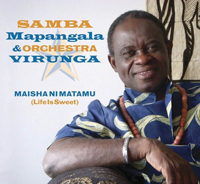
SAMBA MAPANGALA & ORCH VIRUNGA
MAISHA NI MATAMU (Virguna VR003)
Samba is back with the message "Maisha ni matamu (Life is sweet)" & he brings some bright danceable rhythms reminiscent of the golden age of Virunga in Nairobi in the early 80s. His new 38-minute long album features a load of guest talent crammed into 7 cuts, some of them actually recorded in Nairobi. On guitar he welcomes Syran Mbenza of Quatre Etoiles, Nseka Huit Kilos formerly with Rochereau's band, and Popolipo from Zaiko Langa Langa: three of the greats. Ballou Canta pops up on vocals and Jimmy Mvondo also brings his sax, along with drummer Komba Bellow, who has appeared on the last few Virunga albums as well as being a mainstay of Quatre Etoiles. Samba sings about the Sauti za Busara festival in "Zanzibar": his appearances there to great acclaim have done a lot to bring him back to the consciousness of the wananchi of East Africa. The album also includes "Les Gorilles des Montagnes" (which came out as a single last year) a song about the endangered gorillas of Mount Virunga in Northeastern Congo. I can attest to how endangered they are because I spent a week in July 1983 trying to catch a glimpse of them, to no avail. However, I did climb the mountain, a dormant volcano, and gained a closer affinity with the band and, after all, what do you do when you meet a gorilla? Avoid eye contact and turn your back to them, bend over and pretend to graze the grass! And despite their sad circumstances it was far more exciting running into the Mbuti pygmies. Samba's new CD, like life itself, is short. It ends with a pleasant coasting instrumental take of "Jarani," a reggae-like number in which Huit Kilos revisits some of his riffs from the days of Afrisa.
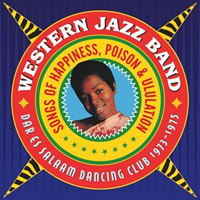
WESTERN JAZZ BAND
SONGS OF HAPPINESS, POISON & ULULATION (Stern's STCD3052)
Doug Paterson strikes again! I have corresponded with this expert in the music of East Africa but somehow Western Jazz Band never breached my consciousness 'til now. Based in the Dar Es Salaam Dancing Club, the band had a career that spanned two decades, but for this reissue, Paterson has picked choice tunes from the brief period 1973-5 that showcase this guitar-heavy band from Western Tanzania and their style of music, called Saboso. The lyrics are all transcribed and translated so we can check out the songs about poisoning a lover or less problematic domestic issues from hardship to greed, trust, bad friends and/or calamity. "Amina" is familiar to me because of the harmony horn chorus and the ringing lead guitar played with lots of echo. The singer urges Amina to finish her studies before they get married. Instead of the pulsing hi-hat or bomping kick drum found in a lot of East African music from the period, the percussion is on congas and the saxophonist is more prominent. However, there are the trademark dueling lead guitars and one of them occasionally starts strumming behind the bridge of his electric guitar to create that chunking percussive beat. Unlike music from the rest of Africa there are no external influences: no Latin quotes, no funk or Britpop, no soul or R&B, just pure inventive harmonies and catchy melodies.
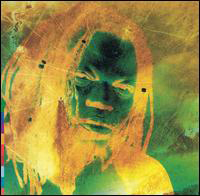
REMMY ONGALA IN MEMORIAM
Born in Congo, REMMY ONGALA moved to Tanzania and performed with Super Makassy & Super Talakaka until forming his own Super Matimila. He first came to Western attention with the stunning album Nalilia Mwana on the WOMAD label. Thereafter he performed regularly at WOMAD. In fact the only time I saw him perform was at the one-off WOMAD/San Francisco in Golden Gate Park. Fortunately he was up against Ziggy Marley so when Ziggy took the main stage everyone flocked there except those 100 or so of us who knew the real event was going to be on the minor stage. We had the "dancefloor" to ourselves. He had a distinctive sound, influenced structurally by Franco's OK Jazz, with Boss Flangers on the guitars and a lyric delivery that is instantly recognisable. If you don't understand the lyrics his songs tend to sound similar but he had potent messages in his words. He was a deeply concerned songwriter who wrote about social injustice, death, AIDS, and other pressing matters. I heard from a musician that Ongala was a terrible boss, a real martinet who would fire anyone who played a lick out of turn. But that's not so unusual among singer-songwriters who know what they want. His Songs for the Poor man came out on the RealWorld label, as did Mambo, while Sema came out on WOMAD in 1995 and reincorporated some of his hits, such as "Kilio (the fish song)," "Fadhili ni utumwa," and "Nalilia Mwana." We were even treated to a Kershaw Sessions disc of 12 songs done live to supplement the early On Stage album which had come out in Tanzania (Ahadi LP6007, 1988). His early work with Orch Super Talakaka appeared on Polydor POLP 538. Around 2000 he was paralyzed by illness and returned to Tanzania where he was a national hero.
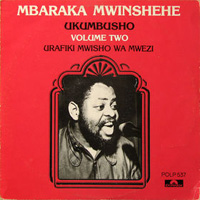
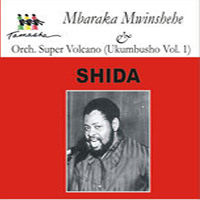
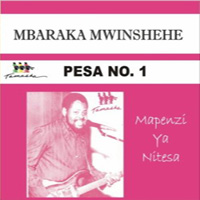
MBARAKA MWINSHEHE & Orchestre SUPER VOLCANO
UKUMBUSHO VOL 1 (Tamasha; orig: POLP 536)
MTAA WA SABA (Tamasha; orig: Ukumbusho vol 2 POLP 537)
PESA NO 1 (Tamasha; orig: Polydor POLP 544)
You probably know the story: Mbaraka Mwinshehe was the biggest star in East Africa in the 1970s, recording in the Polygram studios in Nairobi but touring all over Kenya and Tanzania where he was hailed as a worthy home-grown rival to Franco. But touring was his downfall, as he died in a car crash on the treacherous roads of East Africa (I was in a car on that Nairobi-Mombasa road that hit a herd of goats, not damaging the car too badly but giving the goatherd an unexpected dinner). After his death some 80 of Mwinshehe's singles were issued on LP and have since become one of the grails of East African pop music lore. I've already reviewed vols 6 & 7, and Soloist National, as well as a compilation on Dizim called MASIMANGO which actually remastered the sound, and includes some of the tracks presented here. Here we have volumes 1 & 2 and an out-of-series album which all have duplicated tracks, so beware and don't download the same tracks over and over! Ukumbusho ("Remembrance") volume 1 includes 7 tracks: of these "Mapenzi ya nitesa" and "Dr Klerruu" are repeated on PESA No 1. The opener, "Shida (problems)," can also be found on POLP512 The Last Recordings of Soloist National (1979). "Dr Klerruu" is a tour-de-force of guitar playing: Mwinshehe dampens his strings and creates a bright pizzicato sound almost like a thumb piano. The ragged horn chorus limps along behind him. Mtaa wa saba has the worst sound quality of the three; the title track is virtually unlistenable, the rest is overmodulated. I have a rip from vinyl which is hot but still better than the sound on Tamasha's reissue which probably came from one of those legendary clapped-out dubbing decks that were used in dusty dukas to dub albums in high-speed mode on the cheapest possible tapes. As I said on my Polygram discography page, "Jacinta," "Urafiki" and "Pole dada" are also on POLP 500, a rare Morogoro Jazz album; "Vijana wa Afrika" (which features slide guitar reminiscent of Dr Nico) is also on Soloist National POLP 501; Pole dada" is also on UKUMBUSHO vol 11; "Mtaa wa saba" is on POLP 512 (The Last Recordings) and POLP 517 (The VERY Last Recordings). -- I am not making this up. -- Where there's a demand you fill it, right? Why they duplicated tracks is anyone's guess, it wasn't due to a shortage of material. (But there is a real shortage of photos of MMM, so that is the same picture on all three covers!)
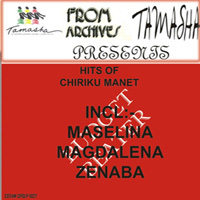
CHIRIKU MANET & VIJANA JAZZ (Tamasha)
It took me some time to realize I know this singer, in fact I already have 5 cassettes by him. That's because I know him as Hayati Hamed Maneti. Calling him C. Manet makes him sound like a French impressionist ("And now, my impression of Maurice Chevalier --- Sank heaven..."). As with Mbaraka Mwinshehe, there was a burst of releases after the death of Maneti in 1990. And they were also called "Ukumbusho," 'Best of," and "Last Recordings." All we know of the group is that Hamet, I mean Maneti was the composer and lead singer. The band was created out of the youth wing of the Chama cha Mapinduzi political party. In 1978 they were allowed to use foreign currency and so bought a synthesizer and drum machine, which of course impacted their sound (in mostly negative ways). Three of the founding members were Hamza Kalala, Issa Chikupele and Manitu Musa. Lead guitarist Kalala, who left in 1986, went on to found Bantu Group in 2000. Of the second track, a comment on the Dalston Oxfam Shop blog says, "Vijana Jazz became a household name with "Niliruka Ukuta" ("I jumped over a wall"), in which the narrator tells the story of his love affair with a woman who didn't reveal her true marital status. He ended up having to jump over a wall to save his life when the woman's husband nearly caught them." That's the second track here. Again the sound is a bit muddy. By track 3, "Magdelina," which showcases the guitars, the band seems to be loosening up. In fact the middle part of this album is more like a great concert than a suite of songs. The vocalists yell exhortations and the guitars cut loose on some wild riffing. "Koka" has an immediacy which is unusual in recordings -- outside of Africa. It's a jamming track, and only 4 minutes long. I would say Mbaraka is as much an influence as Trio Madjesi. These four cuts in the middle of the album are mostly jump in at the deep end jams. The only long number "Zenaba" is more like the early work of Remmy Ongalla, starting out at a leisurely pace. Then they bring us back to earth with a structured final song.
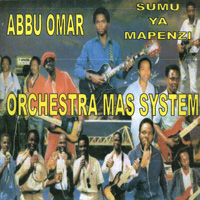
ABBU OMAR & Orchestra MAS SYSTEM
MAWAZO
SIMU YA MAPENZI
Two four-track albums generate 73 minutes of very pleasant music from this artist. He is Tanzanian, though Doug Paterson says he now live in Japan. Classic Benga riffing, sizzling hi-hat, harmony vocals, horn accents, no doubt tearing them up in Tokyo. Apparently these are new recordings. Omar (a.k.a. "Professor Junior" perhaps a reference to Vata Mombasa, who was known as the Professor) previously surfaced as half of the dueling guitars on one of the best reissues of the year: Issa Juma & Super Wanyika Stars' World Defeats the Grandfathers, which Sterns published in May 2010. That album was a real treat and so here is instant gratification in more of the same! Well, Issa Juma is dead & the other band members have gone their separate ways, but the driving guitar and horn sound is there. Big pieces of the Music of Africa jigsaw puzzle fall into place! The Wanyika sound survives and thrives -- in the Ginza! Omar name-checks Ringo Star but I doubt if it's him on the second guitar, more likely a comic reference to the drummer. Philip Lodero, chef d'orchestre, is also name-checked. "Rudi nyumbani (going home)" is also a Baba Gaston song title. "Dunia ina mambo (the world is crazy)" could also be an oldie. All the songs clock in at nine minutes: the A side B side formula for a good groove. Did I mention there's horns too! Would be nice to know who is singing on here. The second album is called "Simu ya mapenzi" which Google translates as "phone sex"-- then a little icon pops up and says "Listen"! Very funny.
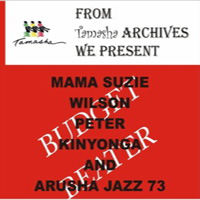
ARUSHA JAZZ
MAMA SUZIE (Tamasha)
Another "Budget Beater" i.e. cheap production. This was a 1973 cassette release by the band that was formed by the three Kinyonga brothers, Wilson, George & William. By 1971 they had moved to Mombasa and changed the name of their outfit to Simba Wanyika. They still recorded under the Arusha Jazz name from time to time, up until 1973. Some of the hits of Wanyika, such as "Pamela" and "Marceline" were orginally done as Arusha. The first two songs here were the sides of a single that was a huge hit for the band, "Mary Mtoto," one of my faves, (here labelled as "Mary Mama") has Simba Wanyika referenced in the lyrics, as do "Eliza wangu (My Eliza)," "Mbaya wako rafikiyo (Your naughty little friend)," and other songs. The opening A-side B-side pair is reason enough to get this disc, perfect combination of shuffling drums, blasting traffic-jam horns and an aetherial guitar solo which descends at the bridge as the vocalist mutters under his breath. "Jose twende Zaire (Jose, let's go to Zaire)," which sounds like it should be called "Mama Josefina," is a great Congo-inspired smouldering jam. But mostly it is distinctly Kenyan and features a tambourine that keeps up a pulse like insect night sounds. This one is well recorded. Note: Doug Paterson warns that the Simba Wanyika album Barua ya Mapenzi with "Maselina" (available from Tamasha also) seems to be missing one channel, so skip that one.
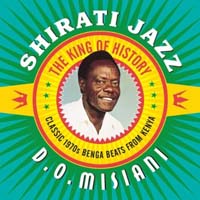
D. O. MISIANI & SHIRATI JAZZ
THE KING OF HISTORY (Sterns STCD3051)
The first thing you have to be ready for with Benga music is the shrill voices. They are not unnaturally high like Bollywood playback singers, but still they strain up an octave. Then you can get into the sheer propulsive energy of it. It is perhaps the speediest music from Africa, and it is stripped for action: two guitars, bass and drums with only occasional sax, or even bottle percussion. Misiani is (or was) the master: this collection comes from the 1970s, which was his greatest era. Misiani, a talented guitarist himself, brought up on Losta Abele, Bosco, et al, assembled the best possible band -- so you don't have a rhythm guitarist strumming on an open chord, a bass playing the one and a drummer keeping a four-square beat: you have four individuals playing their hearts out from the word go. The bass is the most unusual: he is soloing throughout, paying very little attention to the tune or the other musicians. The two guitarists also don't really play together, they make little musical sorties, only occasionally at the same time. The drums are quite bizarre actually. In his classic novel, The Music in my Head, Mark Hudson has a very funny passage about the greatest air guitar song of all time: He goes on about this gem of rock & roll, and then says that when the drums come in they are so badly recorded it ruins everything. The Kenyan drums are not badly recorded, just badly made, I think. They sound like plastic buckets, very different from other trap drums on record. But the high energy guitars and insane bass soloing completely overwhelm any need for sonic fidelity on the tubs. Amazingly, the two albums released in the UK in the late 80s presented a strong showing of Misiani's music, and hooked a lot of us on Benga, but this earlier material is even better!
The CD notes don't say who is on here. However the 1989 album PINY OSE MER, which has liner notes by Werner Graebner, lists D.O. as bandleader, solo guitar and voice, Ochieng Oninga as first rhythm guitar, Juma Obai as 2nd rhythm guitar, and Nyabuon Nyang as merely the rhythm guitar. Two bassists are identified: Okech Oro and Pasy Aloo, with Caleb Odemba on drums. I don't know how many of them were in the band two decades earlier. Trying to explain the name, a fan said "Benga is the feeling you get when dancing." The music was influential in neighbouring Zambia and Zimbabwe, but also as far away as Nigeria where it was popular among fans of Ibo highlife. The direct influences on the sound might be traced to the orutu, a traditional one-stringed violin, or the nyatiti, the 8-stringed lyre. These can be heard on the Hugh Tracey recordings of the 50s, if you want to look for parallels in the rhythm and lead guitar. Although the Luo are only the third-largest ethnic group in Kenya their music became hugely popular in the 70s and eclipsed the other forms of Swahili- and Congolese-language dance music in East Africa. Misiani's pointed lyrics (couched in fables and folk tales) often got him in trouble with the authorities, and he was once arrested as an illegal immigrant (being from Tanzania) but not deported. At their peak Shirati Jazz sold 20,000 singles a month in the 70s, but in the 80s piracy and cassettes severely dented the African music industry. Misiani, who died in 2006, would have been amused that Barack Obama, son of a Luo man, became president of the United States while Kenya has never had a Luo president, Doug Paterson tells us in his liner notes. The booklet includes photos and translations of all the songs.
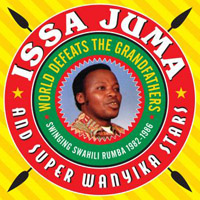
ISSA JUMA & SUPER WANYIKA STARS
WORLD DEFEATS THE GRANDFATHERS (Sterns STCD3050)
While the music industry is going through great upheavals as modes of distribution are changing overnight, it's reassuring to know there are still labels with confidence to put out classic music that will have a limited appeal, in the hopes that a broader audience will develop for it. Maybe folks will appreciate it enough to support such ventures and not screw them into oblivion by stealing it. Stern's have apparently closed their flagship London store but the label is going strong & this release signals, hopefully, a move to East Africa after their triumphant series of Guinean danceband classics compiled by Graeme Counsel. Most of us in the West first heard Issa Juma on Sigalame 2, the phenomenally great 1990 compilation from Discafrique. Issa's throaty baritone was irresistible. I played "Pole pole" so many times my LP has skips in it. The story of his band, Les Wanyika, has been told before: suffice it to say they were the top Kenyan band in the 80s, resisting the onslaught of talent from the Congo that included Samba Mapangala, Moreno Batamba, Lovy Longomba and many others. The founders of Simba Wanyika (Lions of the Wild), Wilson and George Peter, played dueling lead guitars and Professor Omar backed them on rhythm, but their singer, Tanzanian-born Issa Juma wanted more control and so, inevitably, the group split and many other factions with many other names (Super Wanyika, Super Les Les, Wanyika Stars, etc) appeared. However this compilation has the constancy of Juma's fabulous vocals atop all of it and documents only the latter part of his meteoric career with Super Wanyika Stars. So, although the album is drawn from five different sessions, it's all unmistakably Issa's music. The compilation is by Douglas Paterson, leading musicologist of the East African field, and broadcaster on KBCS radio, who has previously given us such gems as The Nairobi Beat (Rounder) and one of my all-time favourite LPs Karubandika by Orchestra Maquis Original from Tanzania. The album kicks off with "Barua (The Letter)", a minor gem that was on the LP Mpita-Njia. Two more cuts from that 4-track disc appear here in all their restored glory. Then we hear a previously unreleased "sax" version of "Ma Eliza" which is consequently new to everyone. "Mwanaida" was on the B side of the Bwana Musa LP, while "Utalia na nani" is culled from the B side of the great Pole pole (slowly slowly) disc that was the basis of the Discafrique release. Chances are, you don't have most of these, unless, like me, you have been trying to track them down for the last 30 years (since they came out). There's a great spareness to the sound. You can hear the ticking high-hat, bustling bass and the interplay of the busy fingerpicked guitars, but it's mostly about the vocals. For a comparison I played "Si mimi," the opening track on Mpita-njia and then the restored version. I couldn't believe it: the new version has much more defined stereo separation and is crisper. Not only are all the pops & ticks from the vinyl gone, there is a vast dynamic range as big as the Rockies wherein you can hear both guitars, bass and drums as clear as ether. The sax solos also nicely complement Issa's voice. This is the way it was meant to be heard and lifting the veil of muteness (that comes from cassettes and badly dubbed LPs) enhances your pleasure in hearing this fantastic singer, his chorus and musicians as he sounded in the A.I.T. studio. There is a crying baby on the song "Utalia na nani?" which I find annoying, but I suppose it was a novelty at the time. The disc ends with another gem: the original Kenyan mix of "Mony," a lovelorn ballad. It differs from the version on Sigalame 2. There is a "download-only" track, "Ateka," for those buying the album on MP3 from iTunes or Amazon, that was also included on Sigalame 2, and is well-worth having.
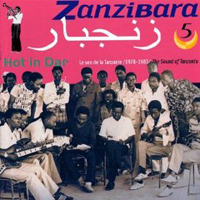
ZANZIBARA 5
HOT IN DAR: THE SOUND OF TANZANIA 1978-83 (Buda Musique 860184)
I've been excitedly awaiting this release since I saw it mentioned months ago and I was not disappointed. During this period (1978-83) East African music was on fire. Bands from Congo were erupting all over Central African airwaves and when the competition got too hot in Kinshasa, many of them moved to Uganda, Kenya or Tanzania. The local bands either absorbed the new musicians or picked up ideas from them to preserve their own market share. Three of the biggest bands in Tanzania were Mlimani Park Orchestra, Dar International and Vijana Jazz. I heard them on the radio in East Africa at the time and when I returned to the West sought out the albums that occasionally turned up in my relentless quest through the record bins of Paris, London, Washington, etcetera. I amassed a mountain of cassettes that formed the basis of one of my discographies on this site. I also have singles by Mlimani and Vijana Jazz that are talismata or fetish items -- not in the sexual sense, but "inanimate natural or cultural objects believed to have magical power." One of the most magical songs of Mlimani "Visa vimenichosha (I am sick of this story)" kicks off this comp. It sets the mood for an hour of transcendent bliss. In the West we have different musics for different age groups and social classes but in places like the Dominican Republic, Haiti and much of Africa, everyone from toddlers to geriatrics are hip to the current sound, and it is all-pervasive. Muziki wa dansi, as this sound is called in Kiswahili, was ubiquitous in East Africa at that time. Not just because of bands that played all night concerts, but every radio was tuned to the same state-controlled station which was also the place where bands would go to record, so whenever a band had a new hit it would be blasting from every corner. LPs are of course a scarce commodity in East Africa. Every time I tried to buy one I was offered a cassette tape instead, and not just any cassette but a cheap one that had been dubbed in hi-speed from a questionable master on a well used tape deck. Consequently most of the music from this era -- such as the Ahadi cassettes which were essentially sanctioned bootlegs from the radio station's master tapes -- are muddy. Werner Graebner, the compiler AND engineer on this set, has remastered these tracks so they are sparkling in their clarity.
Dar International was formed in 1978 from members of NUTA Jazz. Band-leader was guitarist Abel Balthazar and he hired singer Cosmas Tobias from Dar Jazz. But ego clashes caused the band to fracture and several, including Balthazar, left to form Mlimani Park, again filling the ranks from the former members of NUTA including singer Hassani Bitchuka. The longest track on here is Dar's "Uzuri wa asili (natural beauty)" which clocks in at over 9 minutes. It has a great organ underpinning and floats on dreamily, till the guitars get their groove on. While some of the guitar styles are Zairois, the singers kept local traditions alive and this was important especially in the rhythms they adopted. Mlimani was famous for its Sikinde style (also the title of a hit included on the essential Tanzania Dance Bands vol 1, compiled by Graebner for Monsun Records in 1989), and they had a great arranger in saxophonist Michael Enoch who arranged the battles between three trumpets and three saxes that form a key component of their complex style (so Graebner tells us). Vijana Jazz is represented with one song, "Niletaka iwe siri (I wanted it to be our secret)", a Cosmas Tobias song done during his brief stint with them. This is guaranteed to make you want more, leaving the door open for another compilation devoted solely to Vijana Jazz. The booklet is wonderful, with rare photos, complete lyrics in translation and a fine essay by Graebner.
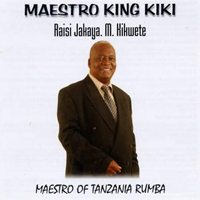
MAESTRO KING KIKI
RAISA JAKAYA M. KIWETE (13s planet 006 UK)
Nothing groundbreaking from King Kiki here, but it's nice to hear one of the old-timers still putting out quality material. His sound at times reminds me of early eighties Afrisa of Rochereau, but is unmistakably Tanzanian rumba (from the golden era). However it is a new recording and he has a bunch of compatriots from the Dar Es Salaam music scene in his band providing the mellow ambience. Like many others, Kiki started out playing in a band as a lad in Lubumbashi, Congo, in 1958, aged 11. As a fan of Cuban as well as Congolese Rumba he graduated from band to band, including Super Fauvette, Safaris Nkoy, African Fiesta of Dr Nico, and Maquis du Zaire. The latter of course moved to Tanzania and became huge, but in 1979 he left to form Orchestra Safari Sound. He sings in seven languages and his band plays in as many styles, though all of them have that wonderful horn-and-guitar driven groove. I could do without the synthesizer on here, but it is minimal. The vocals are strong, the songs about love, harambee, unity, and the old rumberos. 13s Planet Records has put out a range of great East African music by some of the surviving bands, this one is not to be missed.
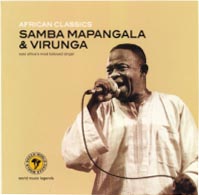
SAMBA MAPANGALA & VIRUNGA
AFRICAN CLASSICS (Sheer Sound SLCD149)
Samba Mapangala was part of the wave of Congolese immigrants who brought their music to East Africa in the 70s when the Kinshasa scene became overloaded with talent. He played in some bands in Nairobi, notably Les Kinois, and was thinking of going home to recruit a new band when he decided to make a few recordings first, and so he took a mixture of guys he had played with or knew from the local music scene into the studio in Nairobi, and Virunga was born. Virunga is a dormant volcano, the third highest peak in Africa, in northeast Congo near the Ugandan border. Giant arborescent heather grows there and it's so quiet you can hear the creak of bamboo growing! But Virunga the band requires you turn up the volume. Though Samba Mapangala veered off into the Quatre Etoiles realm when he was in Paris, producing a series of albums that were indistinguishable from Four Stars' other Paris productions, there is a distinct Virunga sound, and we are treated to over an hour of it on this bright compilation. Three of the cuts appear for the first time, so this will be a must-have for Kenyan music fans, as well as people who dig Congolese dance music, because Virunga straddles both benga and soukous with their high-energy music.
Doug Paterson has done a great job of remastering the sound so it is clear as a bell, and I suspect this was not easy on the three old tracks that he dug up for this set. He also went back to sources to improve the sound of some songs that have been previously on CD, but with flat dynamics. I was fortunate to hear the band at the Starlight nightclub in Nairobi in 1983 and consequently became a life-long devotee of their music, as well as of their splinter groups. I can't believe I actually saw Moreno, Coco Zigo Mike & Fataki Lokassa on stage, though of course I had no idea who they were then; just that I loved the sound. Though there are several Virguna CDs on the market, the Roots album only had 4 songs from the Nairobi days, intercut with tracks from Paris when the sound had switched to soukous. I don't like the alternating sequencing on that disc, so here's the first chance to hear a great continuous selection of genuine golden oldies, and not a slack track on the front or the back. Among the new entries is "Mabiala"-- a praise song for a diplomat, and not a paean to the great Prince Youlou. It really tears up the floor. "Sister Ali" is a love song by Mandala Muisa. "Fonseka" is another praise song for a Starlight nightclub regular. In addition there are two songs from the Feet on Fire LP, "Sungura" and "Vidonge," & two of the big hits from Virunga Volcano, "Malako" and "Yembele." Both of these albums in their entirety are solid, but the inclusion of tracks previously only released in Africa is truly welcome. Three more, less familiar tracks, round out the set, and confirm what we knew, Virunga really were one of the Classic African bands.
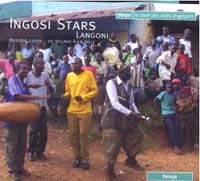
INGOSI STARS
LANGONI (daqui EE02EE)
This is Luhya Music from Kenya, subtitled "from village to town". It is traditional music, played on traditional instruments, and is a rewarding slice of vibrant folk music. While listening I kept hearing echoes of the Georgia Sea Islanders and other black American music, but I think there is a thread that unites all great folk music no matter its origin. The album is a testament to the perseverance of the producer, Denis-Constant Martin, who first met the performers in Kenya in 1980 and never forgot the impact of their wry songs about life in the slums of Nairobi. Returning in 2000 Martin ran into Mzee William Ingosi Mwoshi again, quite by chance, and arranged for him to perform in France at the Festival des nuits atypiques. This was most fortunate for the Kenyan because he was in an advanced state of cancer and on arrival in France was hospitalized and an operation quickly performed which saved his life. Ingosi plays the shiriri, a one-stringed fiddle. He was a favourite performer of Jomo Kenyatta and wrote a much-loved song about Independence, "Mwana wa mbeli (the first born)" with which the CD opens. His pal, Joshua Mwami, master of the itunga, or Luhya lyre, had passed away since the producer first encountered them, but Ingosi's son, Jackson who has mastered the guitar, also plays the 8-stringed lyre with great accomplishment. This thoroughly enjoyable disc is handsomely packaged and includes all the song lyrics in translation.
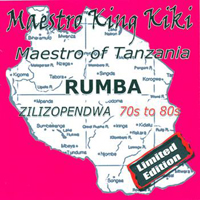
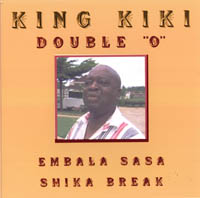
KING KIKI
ZILIZOPENDWA (Ujamaa Records URKIKI01, from Stern's)
EMBALA SASA SHIKA BREAK (no cat no, from Natari)
Some things definitely get better with age: whisky, cheese, and Tanzanian "muziki wa dansi" among them, and some music is so hard to find that when you do find it you have to grab it. Swahili rumba is one of the most enduring and wonderful sounds. The drumming is light, the guitars lyrical, the vocals heartfelt, the saxes bleat prominently. I am constantly tweaking my East African discographies and discovering more and more music from the classic bands of the 70s and 80s, but there are a few survivors still making music in the tradition. Over a decade ago RetroAfric put out the great Shikamoo Jazz volume one and I have been hoping for the sequel ever since. At the same time Dakar Sound put out Leila by Bana Maquis, a group comprised of survivors from the great Maquis du Zaire. The 11 cuts on King Kiki's Zilizopendwa: Maestro of Tanzania compilation from Ujamaa demonstrate the range of his talents as performer and songwriter and underline the prominence he still holds in the Dar Es Salaam club scene. For four decades, he and fellow Congoman Ndala Kasheba (who died in 2005 at 58) were in and out of the great ex-pat bands like Orchestre Safari Sound (then Safari Nkoy) in Tanzania. Kiki toured East Africa first in the 60s with Orchestre Fauvette, sang with African Fiesta Sukisa for a spell, then, moving to Dar Es Salaam, he played with Maquis du Zaire, and then formed his own band King Kiki Double "O", all of whom are sampled on the Zilizopendwa compilation. Inevitably, in the context of classic rumba, there are comparisons to be made to Franco and Mbaraka Mwinshehe: the Zilizopendwa album has a great staggered Franco lead as the musical leitfmotif for the opening cut (though they shout out Jean Bosco Mwenda, which may be a more accurate touchstone for their sound, as he is one of the giants of the finger-picking style derived from likembe). The success of Congolese musicians in East Africa was due to the immense popularity of Franco and other bands: local bands imitated the Kinshasa sound and so when authentic Congolese musicians showed up they were treated as royalty. The more than 200 musicians from Eastern Congo that headed to Dar Es Salaam in the 1970s were also familiar with Kiswahili and could adapt their snappy rhythms and sweet melodies to the local taste. Strife drove musicians out of Kivu and Katanga, but if they made it to their own capital they couldn't survive without rich patrons and an inside grasp of the politics of the club scene, so many of the bands went to Burundi or Uganda. But then there was Idi Amin and other serious obstacles to their continued success, so Tanzania was an optimal destination. The music evolved away from the Congolese rumba into its own sound that evokes warmth and happiness with the pulse of it. It conjurs feelings of dancing the night away in a sweat while insects batter against preternaturally bright lights in the dim air, as smells of cooking mingle with kerosene, paraffin from lamps, and the rich red earth that is not far away from the tiny bit of civilization perched tentatively on African soil with its toes in the Indian Ocean.
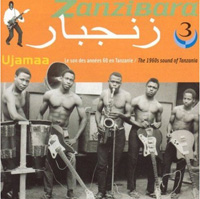
ZANIBARA 3
UJAMAA: THE 1960s SOUND OF TANZANIA (BUDA MUSIQUE 860142)
We can now add "Ujamaa" to our Swahili vocabulary with "Uhuru," "Baraka," "Harambee," and so on (If you want to sound really white try "Moja pilsner baridi ingine, tafadhali"). "Ujamaa" means African Socialism, based on values of family and community, and was the resolve of the 1967 Arusha Declaration. (Though given the 2007 Arusha Declaration to stop fighting between the Sudanese government and rebel armies it's a wonder "Ujamaa" survived at all.) But in 1967, the newly independent Tanzania went into a period of self-sufficiency and nation-building that included state-sponsored bands such as NUTA Jazz and lesser-known bands of the police, army, bus service, etc. The music is similar to Congolese, even covering Cuban-derived styles like the kiri kiri of Docteur Nico, except in Tanzania the music is a bit more laid back: there's multiple guitars and percussion, but the sax is a lead instrument and the singing is usually choral rather than solo. There's also taraab influences in the singing of bands like Atomic or Morogoro Jazz. Other Congo influences were brought by musicians from Eastern Congo looking for a gig in a less-crowded marketplace, but there are also thumb-piano traditions that were adapted into pop music all over Central and East Africa in the 60s, as documented by Hugh Tracey.
In the 1950s Megs Shag, owner of a record store called Assanand's in Mombasa, started recording local bands with a reel-to-reel recorder and a single microphone. But after independence such private enterprises were banned and the national radio station became the sole venue for bands to record. Bands made an annual pilgrimage to the station in Dar Es Salaam to record monaural tapes, which were ostensibly for radio play, but some were snuck out to Kenya where they did a brisk trade as cassettes.
Today these Tanzanian dance bands are legendary, thanks to releases like MUZIKI WA DANSI (Africassette) and reissues on the Dizim, Monsun, and Popular African Music labels. Featured on this reissue, compiled by Werner Graebner, are Atomic Jazz, NUTA Jazz and Morogoro Jazz. There are also two tracks from Jamhuri Jazz and one from Dar Es Salaam Jazz. The two Jamhuri tracks appeared on Jamhuri Jazz Band vol 3 (Tamasha CD2012). They also appeared, with three of the other tracks on HITS OF THE 60s (Polydor 508), a truly rare album; Mbaraka's "Nimechoka" was on UKUMBUSHO vol 11; the NUTA tracks were on OLD IS GOLD: ZILIZOPENDWA (Polygram 557), one of my treasured LPs. But that only accounts for a handful. What this represents is a gold mine of classic Tanzanian music, sounding as good as new. The complete personnel are listed, the lyrics are translated, the sound is restored impeccably, and there are great historic pictures of the bands, maps, ephemera, and other photos. Now I don't want to start ranting in the middle of this panegyric but I have an issue that needs to be raised: the tendency of (mostly white, I suspect) people to treat this music with a colonial mentality. "It's great, so let's just put it on the net for anyone to hear." This devalues the music. I am not saying it should be the exclusive province of people with great wealth who can buy the copies that turn up on EBAY, I am saying this music should be respected. Before throwing it onto a blog it should be researched and properly documented. Optimal copies should be tracked down. Anyone downloading should pay nominally for the privilege and the money should be put in escrow to go to the descendants of the composers. Then there will be some parity with Western artists who get their royalties. I am sick of seeing sites with crappy-sounding singles ripped from cassettes and a note saying, "This is cool, I don't know anything about it but look here..." and a link to my pages. I've given up asking these clowns to respect my copyright, but ultimately they will kill the demand for CDs (& their crucial liner notes) and there won't be anyone, like Budamusique, taking the trouble to produce a magnificent package like this. You have to buy this, for the music, for the package, and to safeguard the future of the music!
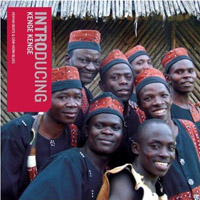
INTRODUCING KENGE KENGE
ACOUSTIC ROOTS OF KENYAN BENGA (INTRO07CD)
How wonderful that World Music Network has decided to issue some genuine folkloric music instead of sticking with the safety of tried and tested formulaic pop music from Africa. I don't imagine this will break sales records but it's a really monumental album. There's continuity with the Benga Beat that was popular in the early 80s but also a deep-rooted tradition that goes back to the 50s and beyond. In fact I note references to older tunes which can be heard on the Mother Lode: Hugh Tracey's recordings made in the 50s in his peregrinations around East Africa. It's acoustic Luo music and there's no guitars (apart from a bass perhaps), so don't expect it to sound like Shirati Jazz at first listen. The group is about 20 years old, their name means "Fusion of small, exhilarating instruments"! Originally the Catering Levy Trust Choir, they were government men who collected hotel taxes. While the choir sang religious and patriotic hymns, the band were more into exploring the roots of Luo music and evolved away from the functionaries to be an independent professional band. The Luo come from the area around the bottom of Lake Victoria, close to Tanzania, who were influenced by Bantu music from the Congo on the other side of the great water (It looks like an ocean and has waves crashing on the shore). They use flutes, animal horns, the orutu (a one-stringed fiddle), nyangile (a gong), and hand drums and they rock. It's great to know this music exists & is so vital. The fiddle and the flute may not seem like exciting instruments but there is some virtuoso playing, excellent drumming, and it's well recorded. It stands alongside such other neo-traditional gems such as Classic Swede Swede (from Congo) and Zagazougou (from Ivory Coast). While it shows evolution from the Luo roots heard & recorded by Tracey, there is continuity in most instruments (the Luo lute is extinct) and when they sing about Jimmy Rogers ("Chemirocha") in the last track my joy abounds and their journey home is complete.
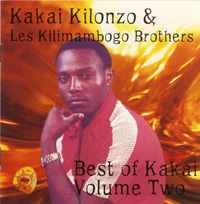
KAKAI KILONZO & KILIMAMBOGO BROTHERS
BEST OF KAKAI VOLUME 2 (SHAVA CD017)
If soukous is the rock and roll of Africa, then Benga is the Country and Western music of that great continent. Around 1980 Benga was peaking and even began to get distribution in England thanks to visionary labels like Discafrique and Globestyle who put it out there to compete with Stiff Little Fingers, Young Marble Giants and Clock DVA for the adventurous record-buying public. Though it began in the mid-60s among the Luo-speakers in Western Kenyan, Benga quickly spread to Nairobi and Mombasa, and by the 1970s was popular enough to be recreated in other dialects. In 1972 18-year-old Kakai met the other musicians who would form Kilmambogo Brothers and began to study guitar and write songs about the everyday trials and tribulations of life. His songs, written at first in Kamba and later in Kiswahili, began to appear in 1974, and after successful appearances on Voice of Kenya radio he sold the copyrights to raise money and start Kilima Mbogo Brothers Band. This second collection of their hits is from a wider time-period than volume 1, covering their earliest recordings which were 4 minute songs and extending up into the mid-1980s when they were able to take advantage of the 45 rpm single format for an 8 minute workout. Though most of the songs are under 5 minutes, they do manage to get to the crucial breakdown where the momentum is sustained by the rhythm for a spell as the lead guitar and vocalist regroup for a final blast. Sadly, Kakai died in 1987 right at the peak of his popularity. His songs are really catchy. From the start of "Punguza ulevi" you will be singing along "Susanna-ye, Susanna-ye, Susanna wacha nikwanbie-ey" and then delight in the lyrics (printed in the original and translation): "Susanna is it drunkenness or love? Give up that bush alcohol you are drinking, you are emaciated and dirty, covered in snot and tears from so much beer"!! (My paraphrase.) At over 8 minutes, this is a small masterpiece. "Bibi yangu nakupenda (My wife, I love you)" really does have a Country twang to it. The songs have been lovingly remastered and sound crisp and clear. If you enjoyed volume 1, which is all A- and B-sides from their mid-80s hits, you will really dig more of the Kilimambogo Brothers.
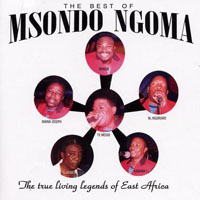
MSONDO NGOMA
THE BEST OF MSONDO NGOMA (Ujamaa Records, available through STERNS)
Subtitled "The true living legends of East Africa," this is quite a remarkable, not to say magic disc. Tanzanian music is some of the finest, most enduring popular music to come out of Africa. Sure there are fads for soukous, bikutski, salsa africana, mbaqanga, but they seldom last more than a lustrum, a decade at most, so it's no small wonder that this group has endured. Broad-gauged studies of the constellation of Tanzanian popular music in the last thirty years inevitably end in necrological bric-à-brac as junior currents shoot forth from the mainstream only to vanish. However a modicum of attention to current releases will reward the listener with this many-splendored opus. The trail-blazing band was formed in 1964 as NUTA Jazz Band, named for the National Workers Union. Their ZILIZOPENDWA or OLD IS GOLD albums on Polygram (POLP 557, 621) are classics. (The latter is in print and available on Tamasha CD from Biashara.) Their lead singers Hassani Bitchuka and lead guitarist Abel Balthazar defected to form Mlimani Park and the group reformed as Juwata Jazz. In 1991 the two defectors returned to the ranks and the band crystallized as OTTU Jazz for their new sponsor, the Organization of Tanzanian Trade Unions. You will recognize "Tupa Tupa" as it's on MUZIKI WA DANSI. Here it's a different take, a sharply silhouetted safari over familiar terrain carried off with flair. The songs are in Swahili, the sound is old school rumba, with horn choruses, mingling guitar licks, and fine solos and vocals.
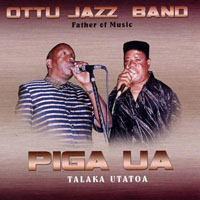
OTTU JAZZ
PIGA UA, TALAKA UTATOA (Ujamaa Records, available through STERNS)
This album came out a couple of years ago but was in scarce supply. If you can find a copy, grab it. If you like classic Tanzanian dance band music (and who doesn't?) then you will love this. It's from the third incarnation of the band that started in the 60s as NUTA Jazz, became Juwata Jazz, then OTTU Jazz and is now Msondo Ngoma (see above). 65-year-old Muhidim Ngurumo is the band leader; he shares lead vocals with TX Moshi William. They have several guitars including the great Saidi Mabera on lead (he joined the band in 1973 and was leader through the 1980s), bass, drums, a conga player and two trumpets. The group was formed in the era when big organizations bought instruments & hired a band who were salaried employees, playing for company gigs; Mlimani Park, Tancut Alimasi and Vijana Jazz all worked to this formula. The six cuts are relaxed ten minute jams with a song, exposition, and jam. And, of course, the twin trumpeters come to the mike at the right moment to take it through the roof & up to the heavens. It's great someone is still making the classic East African rumba: bits of it glimmer up from time to time but here is a major dose that makes an essential companion to the Msondo Nogma album.
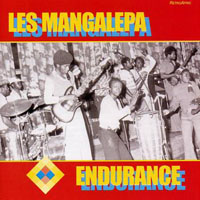
LES MANGALEPA
ENDURANCE (RetroAfric 21CD)
Another African classic from RetroAfric. This one doesn't have so much rare stuff as it's drawn from CDs which can be found on the Tamasha label and bought from biashara.biz online. Still, if you haven't plunged into the available four CDs of Mangelepa, this is a wonderful sampler, including many big hits. The first four tracks are their CD NYAKO-KONYA (originally ASLP 2004): "Embakasi," "Maindusa," "Mimba," & "Nyako konya" (on CD from Tamasha TAM0032). This is the cream of the crop. Originally the backing band for Baba Gaston, they left Congo looking for work in Tanzania and after a couple of hit albums as Baba National they split from Gaston and formed les Mangelepa. They waded in between the big guns, Mbaraka Mwinshehe, Maroon Commandos, Simba/Super Wanyika, Virunga, Super Mazembe, and others, to establish themselves as a top act. For some reason RetroAfric consistently mis-spell the name of the band. I await enlightenment on this as I can't believe it's a typographical error. However the name is a corruption of the french "Marquez les pas" or mark time, referring to military bands, as the Kenyan sound has that snicking snare drum laying down the beat. There's also great trombone, sax and a pair of trumpets as well as fine lead guitar by band-leader Bwamy Walumona, and mi-solo from Ambassadeur and Petit Mustang. Lately I've been completely immersed in the ex-pat Congolese Tanzanian sound so it's hard to be impartial. This is more of that great zippy stuff, with sharp melodies, fabulous guitar interplay (sweetened by Boss Flangers) and light percussion that keeps you coming back for more. I even found I have two Baba Gaston LPs and a hit single buried in my archives, which came to light as a result of my Tanzania album web pages, so that was a treat. One of Les Mangelepa's hit songs included here is "Walter," dedicated to a devoted fan. Funnily enough I had a devoted fan of my radio show called Walter so it strikes another happy chord. "Malawi zikama" and the last track "Kanemo" (which have applause grafted on) are harder to find than the rest of the album. I am sure Retro knows the great work done by Gunter Gretz at Popular African Music, however they should also be aware of what's going on at Analog Africa, who have surpassed them in terms of packaging recovered lost gems of African music. I hope Retro will accept the challenge and put a bit more effort into finding really rare music and giving us the sumptuous packaging that makes the difference between a burned CD of some old cassettes and a truly desirable package.
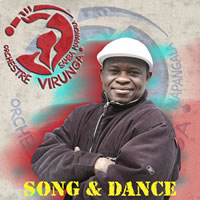
SAMBA MAPANGALA & ORCHESTRE VIRUNGA
SONG & DANCE (VR002)
Orchestre Virunga was one of the great Kenyan dance bands of the early eighties. I have a strong affinity with this band because I saw them at the Starlight Club in Nairobi back in the day, and also climbed the Congolese volcano they are named after! Their singer, Samba Mapangala, was of Congolese origin and moved to Washington, DC in the mid-1990s. However they tour and record in Europe more than the US. He has recorded with some of the Four Stars before and teams up with them again for this stellar outing. You may think the Four Stars are extinct, but this is not so. When Kekele was formed, to recreate the classic acoustic Congolese rumba sound, their producer, Ibrahim Sylla, kicked Bopol out of the group. I will never forgive him for this, but they accepted his argument that otherwise it would not be a new band. However the interplay between Bopol & Syran is one of the most kinetic pairings of the last 25 years and you can't stop electricity from arcing. While there are many guitarists on here, the classic pairing of Syran and Bopol is key. The other solo guitarists -- Caien Madoka and Dally Kimoko -- sound like surrogate Four Stars in their contributions. Nyboma adds his sweet harmonies too so in many ways this is a classic Quatre Etoiles outing. I think the real key is the presence of Bopol who has been on Samba Mapangala's other albums and co-written some of the songs. They don't try anything new (apart from reggae on "Pangen Uzazi"), which is refreshing: they just deliver dance-music with real panache. The melodies are beautiful, with lots of light airy riffing in the arpeggiated Dr Nico style. Komba Bellow plays drums and Deba Sunga slaps the conga. As an added bonus there's Jimmy Mvondo on sax. I hear a synth in there dimly but no one is credited with playing it (probably too ashamed to admit it). This is a consummate party record, sweet and up-tempo.
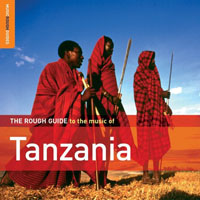
ROUGH GUIDE TO MUSIC OF TANZANIA (RGNET 1158CD)
I've discovered this irritating fact about the Rough Guides. They start with a classic song, then track two is some godawful hiphop dreck to show contemporary youth trends. (Elvin Jones once said he liked hiphop because it pissed-off the older generation and challenged the status quo. I retain the right to be among the grumbling old fogies.) This latest offering follows the formula and has two tracks that can be put in the mute filter (X Plastaz and Dataz: you could almost predict this from their names); otherwise it's a wonderful hour of comforting music from Tanzania, which still has a flourishing music scene. Werner Graebner of Dizim Records is the selector and he explains how the great dance bands of the past have dwindled down to only one or two. Sad, because this is a sound I dearly love; however I have my two drawers of FLATIM cassettes from the golden age to console me. Old favourites Vijana Jazz are up front with "Tambiko" (aka "Tambiko la Pamba Moto"). one of their late 80s hits. Mlimani Park Orchestra is here too, turning it on with their trademark spiraling guitars behind the distinctive voice of Hassani Bitchuka. The were formed as an offshoot of NUTA Jazz in 1978 and are still the darlings of the Dar Es Salaam club scene. NUTA was formed in 1964, and has survived, but is now know as OTTU Jazz Band for the Organization of Tanzanian Trade Unions that sponsors the band. Other styles are still vibrant. A wonderful folkloric piece is performed by Saida Karoli (one of the thrills of this recording). She broke through with her debut album in 2001, and the ballad on here, "Omukaile Kilinjwi," will make you keen to hear the whole thing. One of my favourite cuts is present: "Lukinzi" by the Master Musicians of Tanzania from the album MATESO [Terra CD104], but on hearing it the Duchess muttered the dread disyllable "New Age!" It's the great Hukwe Zawose & his trio on thumb pianos caught in a wonderfully meditative session. The album was originally issued by Triple Earth in 1985 as TANZANIA YETU then extended to an hour for the CD release in 1989.
Another big element in Tanzanian music is the coastal Taraab sound with its Arabic scales, emanating from Zanibar, represented here by Ikhwani Safaa Musical Club, a century-old big band still coming on strong. Zanzibar was a separate country until the First World War when Britain took Tanganyika from Germany and joined it to Zanibar, running both until independence under Julius Nyerere (a leftist committed to self-determination for Africa) in 1961. I heard a BBC news report that Tanzania is the only country in Africa expected to have an increase in rainfall due to global warming, which will mean a boost in crops, animal-life, and of course trade, tourism and economic prosperity. With all the passion for old Juju and Nigerian funk music leading to a flood of reissues of West African music, I keep hoping the punters will develop the same craving for the equally stimulating old Tanzanian sound. I am surprised that this is the first Rough Guide to Tanzania, but Graebner has done a fabulous job and delivered the goods without falling into predictability. It's essential.
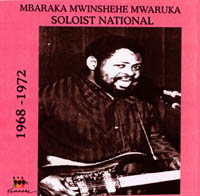
MBARAKA MWINSHEHE MWARUKA
SOLOIST NATIONAL 1968-1972 (Tamasha CD TAM501)
I can't get enough of Mbaraka Mwinshehe. He was known as the "Franco of East Africa" for his presence, his guitar playing and his spellbinding success as a performer. The sound on a few of these tracks is a bit rough, as they were taken from 45s, but it's a marvelous exposition of that rumba sound with snaking guitar lines, punchy horns and a long laid-back groove that stretches to the dusty horizon. This one jumps right in with "Bivelina" and goes into another smoker, "Tambiko ya wahenga." This CD covers the early career of Mbaraka when he was with Morogoro Jazz Band, before he left to form Super Volcano. It only duplicates two of the tracks on MASIMANGO (Dizim Asili Series vol 2): "Tutakuja gombana" and "Matusi ya nini," where they sound heaps better. The latter is an important track because it discusses the rivalry between Morogoro Jazz and Salim's Cuban Marimba Band, another band from the same small town in Eastern Tanzania. It was from them that Mbaraka learned his singing style which is actually Islamic in origin and has a nice descant to it. His partner in the band was Kulwa Salum on chorus and arrangements who also plays the sax that is such a great addition to the vocals and a counterpoint to Mbaraka's dazzling guitar solos. Mbaraka played many instruments and the biggest influence on his guitar playing is the likembe or thumb piano. Apart from wonderfully lyric passages he often creates a percussive style for a rhythmic effect that is quite mesmerizing. Sometimes his guitar even sounds like a marimba (I guess he's hammering on the strings with both hands). On "Vijana wa Afrika" he introduced lap steel guitar and the zoops and whoops are clearly derived from Docteur Nico's African Fiesta rather than country and western or Hawaiian sources. Maybe Werner Graebner, who produced the Dizim release, will get involved and track down the master tapes or find a way to remaster these tracks but, until then, here's your chance to hear some classic Tanzanian music.
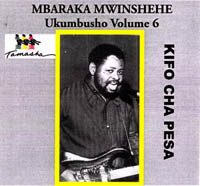
MBARAKA MWINSHEHE
"KIFO CHA PESA" UKUMBUSHO VOLUME 6 (Tamasha CD TAM POLP564)
"Ukumbusho" is Kiswahili for "remembrance," but you probably don't recall these discs, compiled from singles and released posthumously in East Africa. I hadn't heard of Mbaraka Mwinshehe before his tragic death in 1979, then one day, in Down Home Music in El Cerrito in 1984, I found a stack of LPs on the Polydor label that compiled his works. I bought one -- Volume Three -- and took it home. It was stunning so I returned to the store a week later to buy another and found they were all gone and there was not much likelihood of restocking them. This began a quest to find more of Mbaraka. It turned out two of my friends had also bought single albums so I was able to trade them for cassettes and spread the joy a little further. Then I found someone with two cassette releases and we constituted a secret society of Mbaraka fans in San Francisco! There's a hypnotic quality to the music that locks into a groove with big bulbous horn arrangements and Mbaraka playing contrapuntally to the theme in his guitar solos, not unlike Franco with whom he is often compared, though the music is definitely East African rather than Congolese. These recordings were made with Super Volcano, after he split from Morogoro Jazz Band in 1973, but the sound is essentially the same. The songs are all about 5 minutes long but they really seem to stretch out (though I suspect there was a second part to many of them). The players are so confident that it doesn't take them long to break it down and give Mbaraka space to work his magic. The album opens with "Afadhali Umerudi" a nod to James Brown-style funk with a classic drum-break bridge and "stuck" rhythm guitar while the band members yell back and forth, whistle, and urge on Mbaraka who returns followed by the horns in full throat. Sadly it seems to be just part 1 of this gem. There's as much of the Swahili sound familiar from Les Wanyika as the Congolese sound of OK Jazz. The last track "Unaulizwa" is a Cuban-style piece that is sort of a speed cha-cha and highly original.
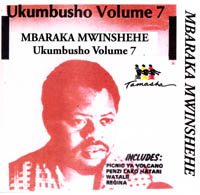
MBARAKA MWINSHEHE
UKUMBUSHO VOLUME 7 (Tamasha CD TAM POLP566)
This disc includes several mega-hits of Mbaraka Mwinshehe, though it clocks in at less than 40 minutes. There's that out-of-tune-sounding horn chorus but some excellent solos from sax and clarinet, choppy mi-solo guitar, and drummer riding the edge of his snare and berating the high-hat. "Penzi lako hatari" leads off the set and fades at an interesting point leading me to think there must be a part 2 that only appeared on the 45. One of Super Volcano's biggest songs is next: "Picnic ya volcano," You might imagine an outing to Kilimanjaro with a case of Tusker pilsner and some "kuku"-- fried chicken-- but it's about the Super Volcano tour of East Africa, from Zambia to Ethiopia. This has an extended breakdown with banter and a few wild trumpet sorties before gearing up for a steaming outro. Curiously one of the vocalists yells "Piciniki, oyé" and gets the reply "Oyé!" This was the "chorus" on an Orchestre Micky Micky single at the same time and it's a funny borrowing (except the original was "Micky Micky oyé!"). They name-check Vata Mombasa, so he may have swelled their ranks for a spell. Another classic, "Nipeleke nikashuhudie," keeps up the momentum. The "B" Side of UKUMBUSHO VOL 7 has two more hits, "Watalii" and "Regina" and ends with both parts of the slow rumba, "Expo 70," a song with "Sayonara Osaka," "Konichiwa," "Arigato gozaimas," and other expressions in Japanese, commemorating their trip to Expo 70. It's sad that none of this material turned up on the Tanzanian Dance Bands releases from Monsun, John Storm Roberts' TANZANIA SOUND or the ROUGH GUIDE series, but it's great that it is finally resurfacing. The former owners of Polygram were notoriously protective of their material to the extant that they would let no one license any of it. Sonically this has the best quality of the three Tamasha CDs and if you are wondering where to start, jump in right here and revel in the roiling sounds of the Super Volcano.
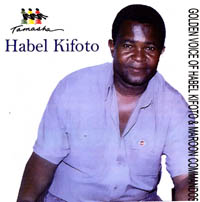
HABEL KIFOTO
GOLDEN VOICE OF HABEL KIFOTO AND MAROON COMMANDOES (Tamasha CD TAM5019)
You probably haven't heard of this singer/guitarist, Habel Kifoto, but you undoubtedly know of the Maroon Commandoes as one of the hippest bands ever to come from military ranks. Formed out of the 7th battalion of the Kenyan army, they had a hit in 1971 with "Emily," but then in 1972 their bus was in a crash in Kenya (sound familiar?) and many of the group died. They reformed six years later and started scoring hits with "Charonyi ni wasi" (which is included here; it's also on KENYA DANCE MANIA), "Riziki haivatu" (also here) and "Amua nikuachi kazi" which appears on the Rounder comp THE NAIROBI BEAT. They affect the big Congolese-style horn section and blistering guitar work. Kifoto has a great throaty almost hoarse voice and this is a relentlessly up and dancing album. The Kenyan aspect is heard in the ticking hi-hat and the arpeggiated mi-solo part with a Flanger on the "sweet" setting. "Ovivu mbaya" has the pleasant addition of organ. There are no liner notes but a 1989 LP I own has a photo of ten band members and songwriting credits go to James Onyango & D. Kibe as well Habel Kifoto. There are great melodies and great harmonies and many of those magic moments I love when everything simmers down to percussion, bass and mi-solo and then slowly comes back to a full boil.
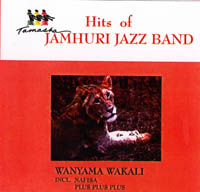
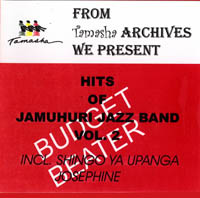
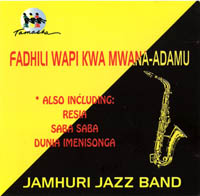
JAMHURI JAZZ BAND
HITS OF JAMHURI JAZZ BAND "WANYAMA WAKALI" (Tamasha CD TAM5005)
VOLUME 2 "BUDGET BEATER" (Tamasha CD TAM2011)
VOLUME 3 "FADHILI WAPI KWA MWANA-ADAMU" (Tamasha CD TAM2012)
Jamhuri Jazz is another outfit that played a key role in the spread of the Congolese rumba sound throughout East Africa in the early seventies. According to a discography of the Wanyikas by John Beadle on Prof Endo's site, "Jamhuri Jazz was founded in Tanga, Tanganyika in the late 1950s, and was one of the more popular Tanzanian music groups. Wilson Peter Kinyonga & George Peter Kinyonga joined it in 1966 and played with it for the next four years before leaving in December 1970 to found Arusha Jazz Band... During the later 70s several of its members, including Omar Shabani, were recruited by the Kinyongas to their group Simba Wanyika."
These three CDs are packed with hits; each is over an hour in length and they are smooth. It's hard to pick one as best. Volume One starts with two slamming grooves back to back "Nafisa" and "Pendo Pesa": the latter has a long break which you imagine is going on forever, then is resolved with a little bleating sax. Superb guitar, great harmonies, catchy melodies, and all sounding crystal clear which is a rare bonus for material of this era. It's true that many bands recorded at the studios of Radio Tanzania but apparently a lot of the master tapes have been pilfered or decayed with forty years of dust and humidity.
Volume Two (subtitled "Budget Beater") has 14 tracks. There is a wider variety of musical styles on this one. The first four songs were released as singles from the Nairobi branch of Philips in 1970; other tracks come from cassettes and greatest hits albums released later. "Shingo ya Upanga" is the Benga sound; followed by "Toyota," a commercial for the Japanese car maker in classic Congolese rumba style (Songs about car dealerships are prevalent in Congolese music); there are frequent mentions of Toyota and VW Azda sprinkled throughout Jamhuri's repertoire! This one is light and sprightly with dancing guitar. Though the group's roots are Tanzanian the sound is more Congolese from that golden era of African Fiesta, Negro Band, Vox Africa, Les Bantous, etc.
Volume 3 is likewise a mixture of tracks and also high quality music in good fidelity. An article in the Kenyan Daily Nation from May last year discussed how Zilizopendwa (or "Old favourites") are big in East Africa now, so we are not alone in digging this classic sound. Mlimani Park Orchestra and others are playing their old tunes and crowds at clubs and weddings are calling for songs by Les Wanyika and Samba Mapangala. While the youth rush off to hip-hop and other misguided crazes, it's good to know the golden era is getting some appreciation in its home soil.
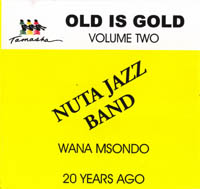
NUTA JAZZ BAND
OLD IS GOLD VOLUME 2 (Tamasha CDTAM CPOLP621)
Subtitled "Twenty Years Ago," this album came out about 1987 on vinyl. There are no liner notes and I cannot find out much about this superb group, but they are part of the Rumba Invasion that stormed East Africa in the 60s. I found a few facts in Ronnie Graham's World of African Music which is Volume 2 of the Stern's Guide to Contemporary African Music. (Volume one was the Da Capo Guide to Contemporary African Music & I cannot figure why they didn't just revise and expand volume one instead of creating a whole different half work. Isn't it time someone paid Mr Graham to rewrite the whole thing as one book with illustrations?) According to Graham, NUTA was formed in 1964. He lists their Zilizopendwa album (Polydor POLP557 1987) and key members Joseph Lusungu and M'nenge Ramadhani. In 1977 they split up and the original members formed Juwata Jazz Band. The defectors, singers Ilassani Bitchuku and Muhiddin Maalim and guitarist Abel Balthazar, formed Dar International which then evolved into the long-running DCC Mlimani Park Orchestra. It's a tangled web but this album could be called the roots of Mlimani Park if you need a handle on the sound. It's very rich, with great sax, fine guitars and high energy. It's not as well recorded as the Jamhuri albums but just as crucial. There are two versions of a song called "Msondo" and both are striking and quite different. It's a study in how a working band can evolve a great song in performance.
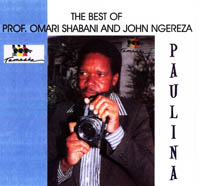
[LES WANYIKA]
PAULINA (Tamasha CDTAM002)
It doesn't say Les Wanyika on the cover, rather it's called THE BEST OF PROF. OMAR SHABANI AND JOHN NGEREZA, so you have to know your East African music trivia to scope out this one. This is a very satisfying release as it has the originals of "Paulina" and "Pamela" (recorded in 1979 and 1980) which were reprised on AMIGO (Clifford Lugard CLP001) in 1998. It's great to hear them in their original form. This album is firmly in the Swahili camp with Tom Malanga's bass high in the mix, and drummer Rashid Juma abusing the superficial parts of his kit behind the intertwining guitars. Les Wanyika were Tanzanian expatriates in Nairobi who quit Simba Wanyika of Wilson Peter Kinyonga and George Peter Kinyonga. Les Wanyika first hit with "Sina Makossa" around 1979, one of their greatest songs. Ultimately, the founders quarreled and rhythm guitarist Professor Omar Shabani was kicked out of the group in 1990 (He died in 1997). Lead guitarist John Ngereza won the power struggle but had never received any royalties for work he wrote while Shabani was group leader. Vocalist Issa Juma also left in 1980 to go solo (& recorded under different names, such as Super Wanyika, Wanyika Stars, Waanyika, Super Wanyika Stars), so there were several offshoots of the band, but I believe he is singing on these tracks, originally released as 45s. Juma died in the late 80s, John Ngereza died in 2000. This is a flash back to their early creative days and is as good as anything made in Kenya in the 1980s.
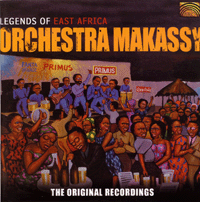
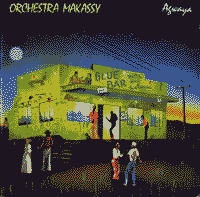
ORCHESTRA MAKASSY
THE ORIGINAL RECORDINGS (ARC music EUCD1909)
The wait is over. A legendary album that came out on Virgin records in 1982 has finally appeared on CD. In addition to the scorching music of the album, a perennial favourite in the Muzikifan household, there are bonus tracks, those magic moments that make you glad to be alive. Orchestra Makassy was first formed in 1975 in Kampala, Uganda by Zairean ex-pats. It was a 15-man band with a nightclub gig in Dar Es Salaam when it assembled in a Nairobi studio in 1980 for some young Brits who wanted to cash in on the Afropop boom that was happening thanks to King Sunny Ade. Mzee ("Elder") Makassy was the leader and principal vocalist of the band named after him; Tshimanga Assosa of Maquis Original contributed singing and songwriting skills (the songs are in Shona, Swahili and Lingala). Mose Se Sengo a.k.a. "Fan Fan" is often mentioned in connection with the band as he had been chef d'orchestre before striking out on his own, and he co-wrote two of the songs on the album, but the guitarists on the record are Aimala Mbutu and Alfani Uvuruge. Remmy Ongalla passed through the band & you can hear the impact of these songs, particularly "Mke Wangu" and "Mume Wangu," on his own albums. The excellent, bustling Kasongo Shinga played bass, and there were two drummers, a tumbador, and four horn players, including Twalib Mohamed as trumpet soloist and Akuliake Saleh on alto sax. In short, a classic East African dance-band line-up. The opening cut, "Mambo Bado," by Assosa, did become a dance-floor hit, at least in the limited world in which I was deejaying. It still gets you going from the first note. "Kufisilika Sio Kalema" is another mover and shaker in the Virunga style. The ballad "Nakolela Cherie" that closes side one is a haunting ballad about a man whose wife has abandoned him and the kids. There is a bright guitar part in the style of "Fan Fan" and muted trumpet adding to the pathos. Most of the songs contain wry social commentary. Side Two opens with "Mosese," obviously penned by FanFan, about a man complaining to his fiancée, followed by "Athumani," a song in which a young married woman complains about her husband running around. The bass is high in the mix for the moody "Mke Wangu," another classic track in which the singer tells of a man who lavished material goods on his wife only to have her leave him. Periodically he says "No smoking!" or "Disco!" in English, seemingly exhortations to the guitarists who are working out. "Molema" by Fan Fan and Makassy originally ended the proceedings, & winds the set down beautifully, but here it's been moved up to make room for a couple of rare tracks that are not as outstanding as the nine on the album, but a pleasant extension. Now things end with "Mume Wangu," which sounds like a retake of "Mke Wangu."
"Mambo Bado" should have prompted the group to international stardom but, despite the care and attention lavished on the recording (for which we are eternally grateful), Virgin failed to promote them and they broke up. Platterbugs will note that there are four tracks on Mose Se Fan Fan's "Belle Epoque" (RETRO 7CD), including "Molema," recorded in Tanzania with the band when Remmy Ongalla was frontman, and there's another album released in Kenya in 1984 MUZIKI ORCHESTRA MAKASSY that no one has!
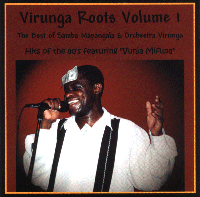
ORCHESTRA VIRUNGA
VIRUNGA ROOTS VOLUME 1 (VS001)
Virunga was formed in 1981 by expatriate Congolese in East Africa and scored hits in the UK with their debut album, VIRUNGA VOLCANO on Earthworks. They continued recording throughout the 80s. In 1989 singer Samba Mapangala made the trek to Paris where he recorded new material with Les Quatre Etoiles, then the top soukous band, featuring the great Syran Mbenza on guitar, Bopol Mansiamina on mi-solo, Miguel Yamba on bass and Komba Bellow on drums. Because Samba's voice is similar to Nyboma's, these tracks sound exactly like Quatre Etoiles. In 1989, the liveliness of soukous had not yet become formulaic and it still sounds fresh on the Paris session until "Belle Femme," which has the plague of Paris: programmed drums and synths replacing horns. After their smash debut, Virunga did not get the acclaim they deserved, but this collection shows they were one of the top African bands of their era. All the songs are by singer Mapangala except a Mutuashi number called "Ntumba" by guitarist Django which is clearly riffing off "Mamu wua mpoy" of Mwamba Déchaud recorded by African Fiesta in 1963. One of the best tracks, "Losako," pays tribute to their contemporaries: Franco, Rochereau, Wemba, Empire Bakuba, etc. Though clearly Congolese pop you will enjoy the East African guitars. There's usually a zippy lead, modest mi-solo and a pumping bass, though eight guitarists are credited on the cover!
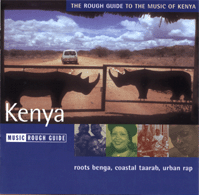
ROUGH GUIDE TO KENYA
(RGNET 1137CD)
There's a mistake on the new ROUGH GUIDE TO KENYA which amounts to a near-fatal flaw in an otherwise excellent compilation: someone messed up the sequence and ruined the flow of the music. As deejays know, a false move can wipe out all the credit you've built with the audience: You clear the dancefloor in one fell swoop, or cause hands to flutter towards the radio and twist knobs to clear the air of the noxious noise. Kenya is a complex country from a musical point of view, having several distinct styles of indigenous music: Benga, Swahili Rumba and Taarab being the most well-known, and of course there's a new wave, inspired by hip-hop and R&B. All in all a real challenge to a mixer trying to present a coherent patchwork from all these disparate bits of sound. The album starts familiarly enough with a Benga gem: Queen Jane, with one of those complaining voices you love or hate, but then we get the new stuff right in our face and you might be inclined to dismiss the CD right from track 2. "Ting' Badi Malo" by Gidi Gidi Maji Maji might grow on you, but at first hearing it's quite alien to what you'd expect from Kenya. If it wasn't in Luo you'd think it was rap from New York. The other up-to-the-minute track is next: it's "Chereko" by Nyota Ndogo and this one did grow on me. Look for her to be a breakout star from this album. Then with a lurch we rip into the middle of Kakai Kilonzo's "Mama Sofia" part two. This is the legendary Kilimambogo Brothers of yore, doing what they do best, taking it to the bridge, and bringing it back in a ferocious jam. Well, good enough, but where is part one? Strange you should ask. Part one appears later like a lost duckling quacking in the middle of Lake Naivasha. What bloody micromanaging meddling twiddling idiot decided to cut this song in two and then have part two first?!! This is foolishness in the extreme. So, boot up your iTunes and start over with the raw material. The Kakai is the best thing on here and you may opt to buy BEST OF KAKAI VOLUME 1 (Shava CD 011-2) instead, to avoid dealing with the rude edit on the Rough Guide. But there are other things of interest, if you can stand the constant cutting from one mood to another. Suzanna Owiyo's "Kisumu 100" is a notable Benga outing, followed by the familiar Swahili rumba stylings of Golden Sounds. More Benga, another arab-sounding Taarab song, and we end up with a very rootsy Luo fiddle & pennywhistle group (which would have been a great transition track between the Benga and the Taarab) that leaves you wondering what just happened.
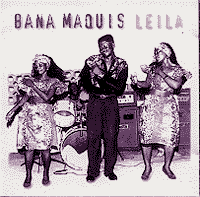
BANA MAQUIS
LEILA (Dakar Sound 2002968 1996)
This is one of the greatest East African albums of the last decade. Just when the old bands were fading away and being replaced by synthesizers and younger groups listening to too many outside sound (like Hip Hop -- shudder), a new album from the members of the Maquis Original restored my faith in great music.
Leader and vocalist Tshimanga Assosa started out fronting the hottest band in Kinshasa in the late 60s: Negro Succès of Bholen and Bavon Marie Marie, younger brother of the great Franco. After Bavon's tragic death in 1970, Assosa headed East and formed Les Maquis du Zaire in Tanzania. By the 1980s they had become the top band in East Africa, singing in Swaheli instead of Lingala, and renamed Maquis Original. Part of the reason for the great success of Tanzanian bands was the studios of Radio Tanzania in Dar Es Salaam which were the main venue for recording and broadcasting the music of the local groups. (Four of the Maquis' hits from the eighties can be found on MUZIKI WA DANSI [Africassette 9403]). Assosa left briefly to join Mzee Makassy in the orchestra that had one phenomenal album, AGWAYA, released by Virgin in 1982. He wrote their hit "Mambo Bado," but when Virgin failed to promote the group and the album foundered, Assosa went back to Maquis. A succession of great guitarists passed through the band until 1994 when Assosa regrouped as Bana Maquis (or the Maquis Kids). From the opening notes you know you're home. The songs are brilliant; the ballad "Afrika Amuka (Africa, wake up)," could move you to tears. A timeless classic.
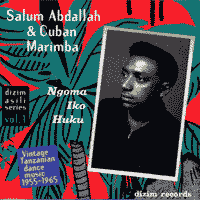
CUBAN MARIMBA BAND
NGOMA IKO HUKU (Dizim Asili series vol 1 ASILL 4701 2)
The reissued Mbaraka Mwinshehe album on Dizim left me gasping for more, so I decided to check out the Cuban Marimba Band release NGOMA IKO HUKU on the same label, though somewhere I have a couple of cassettes by them. Salum Abdallah fronted this band which has nothing to do with Cuba and doesn't feature marimbas! It was just a catchy name, he thought. This CD focuses on the period 1955 to 1965 (when Abdallah, like Mwinshehe, died in a car wreck). There's a taarab feel to the vocals and the guitar is reminiscent of other coastal ngoma dance styles with the fingerpicking emulating sanza patterns. There's a sort of clavé rumba beat that leans to cha-cha-cha and a mix of percussion including shakers, scraped Fanta bottle, congas, and other beaten metallic things. A South African kwela feel permeates a couple of tracks but the classics, like "Wanawake Tanzania" or "Ndiyo hali ya Dunia," are definitely in the Tanzanian mode. Spare, with great guitar, moody sax and plaintiff vocals. Again this is a well-researched, nicely packaged and thoroughly enjoyable release. The sound has been remastered, and the admirable work of Werner Graebner in pursuing these releases deserves recognition and support. It may not be something you'll run out and buy, which is a shame because it will probably go out of print, but it certainly will enhance your collection and enjoyment of East African pop if you do get around to it.
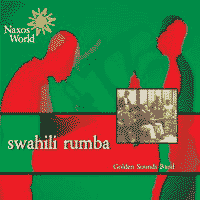
GOLDEN SOUNDS BAND
SWAHILI RUMBA (Naxos World 76055-2 2004)
This may become a lost gem of Kenyan pop for two reasons. The label has reportedly gone back to classical and given up on world music so are not promoting the album, and the band broke up soon after the CD was recorded. Naxos World was an attempt to do a budget line of world music, sampled from all over the globe. Their fatal flaw was in budget packaging too: the covers are undistinguished and unlikely to spur impulse buyers. Golden Sounds Band deserved better. The band leader, Twahir Mohamed, was a very talented arranger as well as sax player. He came from Tanzania in 1984 and featured in Orchestre Virunga during their heyday at Nairobi's Starlight Club. He started Golden Sounds but economic necessity finished off the band even before their CD reached the street. After Golden Sounds he started a new band, but he died in January of this year. As the producer told me, "there isn't a band in East Africa that hasn't lost members through TB or AIDS-related illness." Surprisingly, the music is bright and upbeat (I hesistate to say "infectious"!) Because of the overwhelming influence of Congolese music over the last 40 years, Swahili pop might even be considered a subset of Congolese rumba, but there are enough indigenous rhythms to distinguish it: quite often a backbeat used to start a song. Mostly it rides a sloppy clave beat, and the seben is treated differently as it doesn't increase the tempo so much as fatten the sound. But much of the album suffers from Diblo-itis, a tendency to endless repetition of guitar phrases which works on the dancefloor but not for listening. However it is redeemed by the sax player. The choruses are rich and melodic and as a bonus the topical song lyrics are translated. This album is another reminder of how great Kenyan pop can be: a sparse but joyous music from a country fiercely backsliding into desperate economic times.
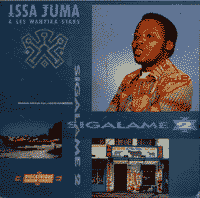
ISSA JUMA & LES WANYIKA STARS
SIGALAME 2 (AFRI CD008)
In Kenya the recordings often sound "fried," through poor acoustics in the recording session or beat-up speakers in the band's amplifiers. Issa Juma was possessed of a wonderful hoarse voice to match his band's sound. The band first hit with the screaming ten-minute scorcher "Sina Makossa" (found on KENYA DANCE MANIA) in 1979, but success caused them to fragment. The core group, led by Wilson Peter Kinyonga, remained Simba Wanyika (Lions of the Wilderness), while Issa Juma's faction were known variously as Wanyika Super Les Les (under Professor Omar who wrote "Sina Makossa") and Les Wanyika Stars, when Issa broke away. To add to the confusion, a third group was called Super Wanyika Stars. The various Wanyika groups, coming originally from Tanzania, were among the biggest attractions in Kenya releasing over 100 singles among them in the 1970s. In 1984 Juma scored a hit with "Pole Pole (Slowly)" and again in 1986 with "Sigalame 2" and both of these tracks, along with four other choice singles were licensed by English label Discafrique for a 1990 international issue. The sound is clean, with the emphasis on the snap of the snare drum, the odd rimshot and the ticking of the cymbals keeping a nervous tension while the expository lyrics in the opening section set the scene for the jam in the second half of each song.
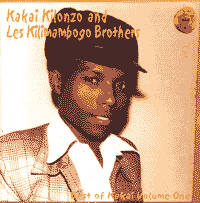
KAKAI KILONZO AND LES KILIMAMBOGO BROTHERS
BEST OF KAKAI VOL ONE (Shava CD011-2)
Kilimambogo Brothers (Brothers of Mount Mbogo) were one of the great Kenyan dance-bands of the eighties, when Benga swept all before it and the songs had that magical two-part structure to fit on a 45 rpm record. The A side was the exposition of the lyric and the B side was the rave up when the band went into a "take it down to the bare bones" bridge then built back up to incendiary height with two guitars fighting for the lead, a thwopping bass and ticking high-hat and snare adding a martial urgency to the proceedings. The guitarists (Kakai, George Onyango, and Francis Kavuu) trade leads while one arpeggiates frenetically in the background, inverting chords and investigating new melodic excursions. A Hawaiian-style slide periodically appears which sounds like unwinding strings, a novel effect. Kakai was a heart-throb too. Though a native Kamba speaker, he wrote his songs mostly in Swahili to reach the broadest East African audience. His lyrics are very entertaining: about the wife who brings home other men while her husband is at work, the man who wants to return his bride to her father because she's a drunk and disturbs the neighbours, the heartbroken lover who cries ("woi woi woi") for his departed Sherina, or the daughter who went abroad to study and never came back. Such little story-fables endeared him to the fans and he even adapted folklore, which people would have recognized, as fodder for his tunes. At their peak they were rivals of Les Wanyika, but Les Kilimambogo Brothers folded in 1987 after the death (at 37) of Kakai. In their career, the band recorded about 36 singles and issued ten cassettes. The only other documentation of them in the West is the last track on GUITAR PARADISE OF EAST AFRICA (Earthworks 1990) and an LP on the PAM label: SIMBA AFRICA. This is a choice collection of their best songs.
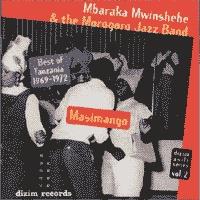
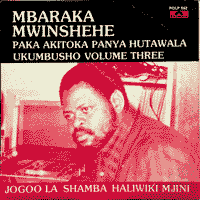
MBARAKA MWINSHEHE & MOROGORO JAZZ
MASIMANGO (Best of Tanzania 1969-72) (Dizim)
Morogoro Jazz, led by the great Mbaraka Mwinshehe, ruled the East African airwaves in the sixties and seventies. They adapted local folk music including Taarab from the East Indian Community settled along the coast. The arrival of the electric guitar changed their sensibilities and regional styles, like Benga from Kenya, were also filtered into their sound, along with pop tunes from the British hit parade and American R&B.
Mbaraka Mwinshehe learned guitar as a teenager, and led the band from the late sixties until he left to form his own band, Super Volcano, in 1973. But in January 1979, Mwinshehe died in a car crash on the treacherous Nairobi-Mombasa highway where herds of wild animals and flocks of goats pose as much of a driving hazard as overloaded market trucks and frustrated motorists trying to speed on the potholed road. Dizim Records has gathered twelve tracks from the Morogoro Jazz band in the volume MASIMANGO (Best of Tanzania 1969-72). The beats are heavily in the Cuban style, though influences from British pop (the Shadows) and American R&B can be heard. Mwinshehe's innovative guitar playing is showcased as he strums behind the bridge, swoops on the neck, deadens the strings to play percussively, or finger-picks in the style of likembe (thumb-piano). He learned to sing from hearing Salim Abdullah, who left Morogoro to found Cuban Marimba band (whose music is the subject of another release on the same label), so his singing has a strong Islamic feel to it. More Islamic traces can be sensed in the haunting sax playing by arranger Kulwa Salum. After Mbaraka Mwinshehe's death, Polygram put out of series of ten LPs by the Super Volcanos [left] and it is hoped Dizim will continue to go through this material for future issues. Mwinshehe's arrangements are occasionally reminiscent of OK Jazz, and he is often called the Franco of East Africa, but there is nothing like the roiling intensity of a Tanzanian dance band.
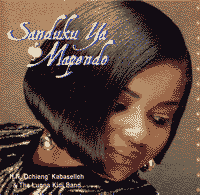
OCHIENG KABASELLEH & LUNNA KIDI
SANDUKU YA MAPENDO (Equator Sounds)
SANDUKU YA MAPENDO is the second CD reissue of material from Ochieng Kabaselleh & Lunna Kidi outfit. The first was FROM NAIROBI WITH LOVE, and both are distributed in the USA by Equator Sounds. The songs are all sung in Luo but share the familiar qualities of Swaheli music. (Crispy fried vocals, jangly guitars, snaky leads, sussurating high-hat, pumping bass). All the tracks start slow and have the seben where at 4 or 5 minutes into the song they kick into overdrive for a dance floor workout with added sax.
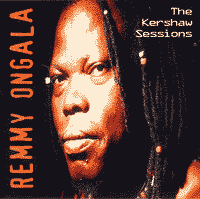
REMMY ONGALA
THE KERSHAW SESSIONS (Strange Roots CD004 BBC Enterprises 1995)
Born to a family of musicians, Remmy Ongala took to the guitar and joined the legendary Orchestra Makassy before striking out on his own in 1988. After a four year hiatus from the great Tanzanian songwriter comes the release of three radio dates, recorded from 1988 to 1993, for broadcast on the Andy Kershaw world music show on the BBC. Allegedly a prima donna who is hard to work with, sidemen revolve through Ongala's band at a great rate. So the personnel differ on each date, but the trademark sound of Ongala is there (sweetly flanged guitar, snappy snare drumming), along with the spontaneity of a loose live recording. There is also the added bonus of a sax on four tracks. Occasionally he sings in English, giving us a glimpse of his ecological concerns, his championing of the downtrodden, and the need for global harmony.
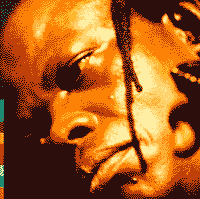
REMMY ONGALA
MAMBO (RealWorld 92129-2)
Ongala comes up strong once again with MAMBO. Here are great vocals from the Voice of Tanzania, sung in English for those who can't enjoy music in strange tongues. Though he may never recapture the peak of his debut album, NALILIA MWANA, that burst on the ears of Western listeners with the impact of Bob Marley's CATCH A FIRE, there is great potential for Ongala to be a breakthrough artist outside Africa. With hypnotic melodies weaving in and out of long jams, this is another strong entry in his growing canon of fine albums. Recorded at Peter Gabriel's Real World studios in rural Wiltshire, England, the album is smooth and sonorous.
(Since I wrote this in 1992, it has become evident that no matter how strong an artist's work is there is a glass ceiling that prevents most African acts getting the exposure they deserve. The marketing gods occasionally allow a Youssou Ndour or Salif Keita to have a moment in the spotlight then become tired of them and claim they've heard all there is to hear from Africa.)
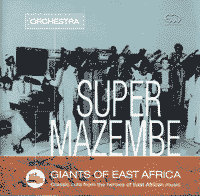
ORCHESTRA SUPER MAZEMBE
GIANTS OF EAST AFRICA (STEW45CD Stern's/Earthworks)
Orchestra Super Mazembe's GIANTS OF EAST AFRICA is one in a long line of classic African albums from Earthworks produced by Trevor Herman. It dates from a golden age in the music, the late seventies and early eighties, just before the rest of the world caught on to African pop. I was fortunate to travel around Africa then and discover the musical riches of Zaire and Kenya in situ. Zaireans Rochereau and Mbilia Bel were the top group of the moment, in fact the Zairean sound ruled Kenya and Tanzania at the time, edging out great local bands like Maroon Commandoes, Kilimambogo Brothers and Les Wanyika. There were so many fine groups coming up in the Congo basin that many were migrating East for work. Super Mazembe, like Virunga, adapted to their new home, adding the glittering guitar sound of Kenya and often singing in Kiswahili. The dominance of immigrant groups was finally curtailed by government edict but the Congolese rumba sound was fixed in the East African landscape. Super Mazembe cover Rochereau's "Jiji" but their biggest hit was a cover of Nguashi Ntimbo's "Shauri Yako (It's your problem)." This stands up to former Earthworks released like GUITAR PARADISE OF EAST AFRICA, and KENYA DANCE MANIA, as a fine selection of super amped-up pop.
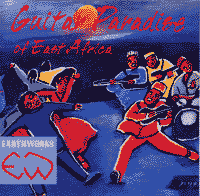
VARIOUS ARTISTS
GUITAR PARADISE OF EAST AFRICA (Earthworks/Virgin EWV21)
Now that Kenyan music is a firmly-established genre we see it shading off into distinct Benga, Luo and Swahili styles, and there is the pervasive influence of Soukous. Zairean expatriates Orchestre Virunga had their VIRUNGA VOLCANO rereleased on CD in 1990, a soaring set of incendiary music from East Africa. But Kenya stems the tide of Zairean bands with its own brand of energetic guitar music. Issa Juma & Les Wanyika Stars SIGALAME 2 and Super Mazembe GREATEST HITS were licensed by Discafrique from Kenyan companies and remixed for Western ears. Both are outstanding. Quavery vocals, dissonant harmonies, jagged spindly guitar lines and brisk hi-hat and snare drumming are the earmarks of Swahili pop, which is recorded with an echoey dance-hall sound. Some of the bands, like Les Wanyika, hail originally from Tanzania, a country which is only beginning to realize its musical potential, with a state-run contest this year to identify the top bands. GUITAR PARADISE (& its companion KENYA DANCE MANIA) is an introduction to some of the less prominent bands, but includes Super Mazembe's monster hit, "Shauri Yako," (originally by Nguashi Ntimbo) one of the most beautiful songs ever written. Another characteristic of Swahili pop is a long drawn-out bridge where the music gets very spare so the recording can be sliced to make an "A" and "B" side, and of course the second half is not so much a reprise as an excuse to cut up the rug and leave the ends frayed.
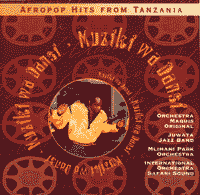
VARIOUS ARTISTS
MUZIKI WA DANSI (Africassette 9403)
Originally issued on the Monsun label in Germany as TANZANIA DANCE BANDS VOLUME 2, it picked up with ferocity on the heels of Volume One, released in 1990. The first volume was devoted to the Mlimani Park Orchestra, a huge ensemble with all the earmarks of the best East African pop music: throaty vocals, rasping sax, jangling guitars, and propulsive drumming that quickly gets under your skin. Subtitled "Marashi ya Dar Es Salaam," the second volume tours the night spots of the capital and showcases Maquis Original, Safari Sound, and Juwata Jazz Band, three of the top bands in East Africa. Though interrelated through member defections, the bands each have a distinctive sound, and Monsun was able to get master tapes from Radio Tanzania for the cream of each band's repertoire.
Technical problems plagued one of the tracks however, so it was that Rick Steiger of Africassette stepped in and reissued the album as MUZIKI WA DANSI. Doug Paterson licensed the same songs in 1991 but it took him several years to find a label to put them out. They dropped "Nasononeka" by Maquis Original and added Mlimani Park's "Edita" and Juwata's "Usia kwa Watoto."
According to Paterson, up to the 90s, Radio Tanzania did almost all the recording in the country. "The problem was not the Radio Tanzania recordings or the fact that it was all mono. Rather, it was the quality of the copies that we got in Nairobi that was the issue. According to Werner Graebner, the RTD archives are in bad shape now. The tapes are disintegrating and/or being stolen."
That there was a wealth of great unreleased material in the Tanzanian state archives is not in doubt. With any luck, the missing or surviving material can be reconstituted into acceptable form and find its place in the market. This CD is just a taste that should see this country get its due in the top ranks of African pop.
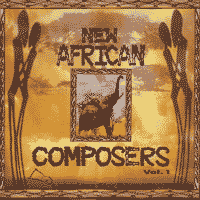
VARIOUS ARTISTS
NEW AFRICAN COMPOSERS VOLUME ONE (Limitless Sky Records)
I must be in an odd space musically, or maybe it's the weather -- not that it's cold here in California, just dark. But nothing is getting me moving. I checked out NEW AFRICAN COMPOSERS and kept thinking, This is new? It sounds like African music of twenty years ago. In fact about halfway through I was having déjà entendu hearing Ndala Kasheba doing "Kokolay" because it sounded like Afrisa International circa 1980, and that is followed by Achigo Band doing "Tebo," a cover of Sam Mangwana's cover of "Maria Tebbo" by Adou Elenga. Not that there's anything wrong with old-school African music, but if you are going to set your band up against the legends, you'd better be as good as Shikamoo Jazz or Bana Maquis, two Tanzanian dancebands of veterans formed in the last decade.
Maestro Ndala Kasheba sounds like he's caught in a time-warp. It's that big horn-rich sound of Rochereau at his peak, or other Tanzanian bands of the late 70s/early 80s. Not surprisingly Kasheba led Orchestra Safari Sound and this harkens back to their heyday. "Mpaka Manga," based on a Congolese folk tune, is the most Rocheroid song. The four tracks included remind me a lot of the old OSS I love from cassettes on the Flatim Records label. In 1985 the band split in two, with half joining up with musicians from rival Mlimani Park Orchestra to form International OSS and Kasheba keeping control of the older band which was quickly eclipsed.
Achigo Band is another regrouping on the New African composers anthology. Led by Nguza Viking, formerly guitarist with Maquis Original, they turn in an epic 9-minute version of "Watanzania watu wa amani" which is reason enough to get this compilation, unless you want to wait for their own album of which this is the title cut.
Yekete Beat Band, high-energy with out-of-tune horns, also come from Tanzania. There are no stand-out musicians or singers, maybe due to the mix, but I would certainly dance to them in a club.To round out the collection, there are two mbira-led tracks by Garikayi Tirikoti which are pleasant, and an acapella religious ballad by Delphin Mununga.
It may be some time before someone puts out an anthology that ranks with Monsun's 1991 compilation TANZANIA DANCE BANDS VOLUME 2, but Limitless Sky have made a step in the right direction.